|
|
|
|
 MANDALA GLOSSARY MANDALA GLOSSARY
A-to-Z Glossary of
JAPANESE MANDALA
125 Mandala in Japan, 50 Photos
Origin = India
Sanskrit = maṇḍala, मण्डल
English = mandala
Japanese = mandara
Chinese = màntúluó
This page was made especially for teachers and students of Japanese Buddhism. It presents everything on one page for easy printout, with links to the most relevant topics and reference notes for further study.
- Maroon Text. Jumps within this page or to another site page.
- Mandala is pronounced “mandara” in Japanese, and hereafter both spellings are used interchangeably.
- Sources. This page relies heavily on numerous sources, but especially on the online JAANUS database.
- This is a work in progress. Any mistakes or omissions are my responsibility. Please contact me when/if you find them.
Four Devotional Categories
- Besson Mandala 別尊曼荼羅.
Mandala devoted to a single deity. Abundant in Japan.
- Betsubu Mandala 別部曼荼羅 or Bue Mandala 部会曼荼羅. Devoted to a specific family of deities. Quite rare in Japan.
- Miya Mandala 宮曼荼羅 and Sankei Mandala 参詣曼荼羅. Devotional paintings of shrine and/or temple landscapes; a map-like illustration showing buildings, pathways, pilgrims, practioners, priests and nuns, deities, and other scenes. Once abundant, but only a relatively small number of pieces still extant.
- Tobu Mandala 都部曼荼羅 or Toe Mandala 都会曼荼羅. Mandala depicting myriad deities from numerous deity families. Abundant in Japan. The most widely known Toe-type mandala is the Ryōkai Mandala.
Four Stylistic Categories
- Katsuma Mandala 羯磨曼荼羅. Deities represented by three-dimensional images.
- Sanmaya Mandala 三昧耶曼荼羅. Deities depicted by symbols/objects (Sanmaya-gyō 三昧耶形)
- Shishu Mandala 四種曼荼羅 or Daimandara 大曼荼羅. Deities depicted in human form.
- Shuji Mandala 種字曼荼羅 or Hō Mandala 法曼荼羅. Deities represented by Sanskrit syllables.
Deity Families & Divisions
Maroon text = Jumps within this page or to other site page.
Simplified. This topic is much more complex. For example, deities in the Kongōkai Mandala
are arranged in nine different panels (or nine mini mandala), while those in the Taizōkai Mandala
are arranged in twelve different well-defined sections. See Kongōkai Layout | Taizōkai Layout
|
MAHAYANA BUDDHISM
Ten Realms (Jikkai 十界)
1. Buddhas (Jp: Nyorai, Tathagata,
Hotoke 仏 -- highest level)
2. Bodhisattvas (Jp: Bosatsu 菩薩);
the compassionate ones
3. Pratyeka Buddhas (Jp: Engaku
縁覚); self-enlightened beings
4. Sravaka Arhats (Jp: Shōmon 声聞); listeners of Buddhist teachings
5. Heavenly Beings
(Skt: Deva, Jp: Ten 天)
6. Humans
(Skt: Manusya, Jp: Ningen 人間)
7. Bellicose Demons
(Skt: Asura, Jp: Ashura 阿修羅)
8. Animals
(Skt: Tiryasyoni, Jp: Chikushō 畜生)
9. Hungry Ghosts
(Skt: Preta, Jp: Gaki 餓鬼)
10. Hells (Skt: Naraka)
Jp: Jigoku 地獄 -- the lowest level
In a larger grouping, there are actually 28 forms in Three Realms (Skt: Triloka).
|
KONGŌKAI FAMILIES
Kongōkai Mandala
1. Nyorai-bu 如来部, Buddha Realm, Skt. = Tathagata-kula; Dainichi Nyorai 大日如来 (Skt. Mahavairocana)
2. Kongōbu 金剛部, Daimond Realm, Skt. = Vajra-kula; Ashuku Nyorai 阿閦 (Skt. Akshobhya)
3. Hōbu 宝部, Jewel Realm, Skt. = Ratna-kula; Hōshō Nyorai 宝生 (Skt. Ratnasambhava)
4. Rengebu 蓮華部, Lotus Realm, Skt. = Padma-kula; Amida Nyorai 阿弥陀 (Skt. Amitabha)
5. Katsumabu 羯磨部, Action Realm, Skt. = Karma-kula; Fukūjōju Nyorai 不空成就 (Skt. Amoghasiddhi)
Before reaching Japan, the mandala traditions of India, China, and Tibet followed a three-family format – the Buddha, Lotus, and Vajra families. Around the 8th century, however, this was replaced by a five-family format.
Related Links
Five Tathagata of Wisdom
Dainichi Buddha
|
TAIZŌKAI FAMILIES
Taizōkai Mandala, Others
1. Buddha = Butsubu 仏部; e.g., Butsugen Mandala
2. Buddha Crown = Butchōbu 仏頂部; e.g., Ichijikinrin Mandala, Sonshō Mandala
3. Sutra-Rite = Kyōbōbu
経法部; e.g., Hokke Mandala, Ninnōgyō Mandala, and Shōgyō Mandala
4. Bodhisattva = Bosatsubu 菩薩部; also includes Kannonbu 観音部; e.g., Nyoirin Mandala, Miroku Mandala, Hachiji Monju Mandala
5. Myō-ō = Myō-ō-bu
明王部; e.g., Aizen Mandala, Anchin Mandala
6. Celestial Gods = Tentōbu
天等部; e.g., Enmaten Mandala, Kichijōten Mandala
7. Others. Deities who personify the planets, stars, and heavenly bodies; e.g., Jūniten Mandala
|
|
JAPANESE MANDALA A-TO-Z GLOSSARY
Aizen Mandala 愛染曼荼羅. Classified as a Besson Mandala, one featuring a single deity from the Myō-ō (Myo-o) Family, in this case Aizen Myō-ō 愛染明王. There are several variations. The Kamakura-era version kept at the Nezu 根津 Museum in Tokyo shows Aizen in the center, surrounded by 16 other deities. Sitting around Aizen are four Bodhisattva and their consorts (representing the four directions and four intermediate directions), while the outer enclosure is populated by the Four Guardian Bodhisattva (Shishō Bosatsu 四摂菩薩) and Four Offering Bodhisattva (Incense, Flower, Lamp, and Perfume). This differs drastically from another Kamakura-era Aizen Mandala kept at Taizanji Temple 太山寺 in Hyōgō prefecture. In this latter work, Aizen is surrounded by four other Myō-ō (Gōsanze 降三世明王, Gundari 軍荼利明王, Daiitoku 大威徳明王, and Kongōyasha 金剛夜叉明王) and four youthful attendants (Dōji 童子), while the outer section is populated by the Twelve Guardian Deities (Jūniten 十二天).
|
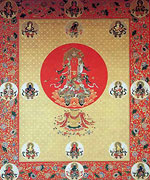
|
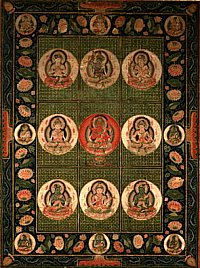
|
|
Aizen Mandala, Courtesy Mt. Koya, Japan
Kongōbuji 金剛峯寺, Mt. Kōya 高野, Wakayama Pref.
In modern Japan, Aizen enjoys great popularity as the god of love & friendship. There is now a 17-site pilgrimage starting in Osaka & ending in Wakayama. See Guidebook (J only) ISBN 4-88602-301-0
|
Aizen Mandala
Courtesy Nezu Museum, Jpaan
Kamakura Era (重要文化財), H 121.2 cm × W 90.9cm
Aizen is the Honzon 本尊 (central deity) of the Japanese Keiaihō (Keiaiho) 敬愛法 esoteric rite of harmony & friendship. This rite is very popular in Japan.
|
|
Akadōji 赤童子 (Akadoji, lit. Red Youth). A painting subject. See Kasuga Mandala.
Amida Mandala 阿弥陀曼荼羅. See Jōdo Mandala and Jōdo Sanmandara. Devoted to Amida Nyorai and the Western Pure Land (Jōdo 浄土).
|
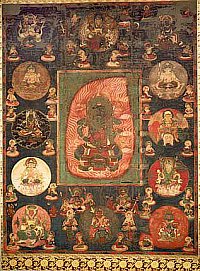
Fudo & 12 Celestials Mandala
不動十二天曼荼羅図
Served as an Anchin Mandala at
Nagato Kokubunji Temple 長門国分寺
Yamaguchi Pref. 山口県
Important Cultural Property
Color on Silk
H 172.7 cm W 130.3 cm
Dated to Kamakura Period
Photo courtesy this J-site
|
|
 Anchin Mandala 安鎮曼荼羅. Classified as a Besson Mandala, one featuring a single deity from the Myō-ō Family, in this case Fudō Myō-ō (Fudo Myo-o) 不動明王. A mandala utilized in an esoteric rite called Anchinhō (Anchinho) 安鎮法, which aims at achieving peace and bringing security to the state. There are variations. In the Tendai 天台 sect, a yellow-colored Fudō appears at the center and is depicted with two arms. In the second enclosure, Fudō is surrounded by eight blue Fudō figures (each four-armed), with each seated inside an eight-spoked wheel. In the outer enclosure are the Guardians of the Eight Directions (Happōten八方天). The Shingon 真言 sect depicts a four-armed Fudō surrounded by the Guardians of the Eight Directions (or sometimes the Guardians of the Ten Directions = Jippōten 十方天). There are variations. See photo at right, depicting Twelve Celestials surrounding Fudō. Anchin Mandala 安鎮曼荼羅. Classified as a Besson Mandala, one featuring a single deity from the Myō-ō Family, in this case Fudō Myō-ō (Fudo Myo-o) 不動明王. A mandala utilized in an esoteric rite called Anchinhō (Anchinho) 安鎮法, which aims at achieving peace and bringing security to the state. There are variations. In the Tendai 天台 sect, a yellow-colored Fudō appears at the center and is depicted with two arms. In the second enclosure, Fudō is surrounded by eight blue Fudō figures (each four-armed), with each seated inside an eight-spoked wheel. In the outer enclosure are the Guardians of the Eight Directions (Happōten八方天). The Shingon 真言 sect depicts a four-armed Fudō surrounded by the Guardians of the Eight Directions (or sometimes the Guardians of the Ten Directions = Jippōten 十方天). There are variations. See photo at right, depicting Twelve Celestials surrounding Fudō.
Benzaiten Mandala. See Tenkawa Benzaiten Mandala below.
Besson Mandala 別尊曼荼羅. Mandala devoted to a single deity. Made in great number in Japan due to popularity of numerous esoteric rites dedicated to specific deities (Bessonhō 別尊法) and specific outcomes (e.g., peace, security, pacification, avoidance of evil, harmony in the home, enlightenment). One of four major mandala categories in Japan. It includes such mandala as the Aizen Mandala, Butsugen Mandala, Ichijikirin Mandala, and many others.
Betsubu Mandala 別部曼荼羅. See Bue Mandala below.
Bu 部. Japanese term meaning “division” or “family.” Esoteric deities are generally classified into one of the following families: Buddha Family (Butsu-bu 仏部), Buddha-Crown Family (Butchō-bu or Bucchō-bu 仏頂部), Sutra-Rite Family (Kyōbō-bu 経法部), Bodhisattva Family (Bosatsu-bu 菩薩部), Myō-ō Family (Myo-o-bu 明王部), Celestial Gods Family (Tentō-bu 天等部), and Others (e.g., star deities). For details on deity families in Japan’s popular Two-World Mandala, or Ryōkai Mandala, see Kongōkai Family and Taizōkai Family.
Bue Mandala 部会曼荼羅. Also called Betsubu Mandara 別部曼荼羅. Mandala devoted to deities in a single family. Relatively rare in Japan. One of four major mandala categories in Japan.
Butchō or Buccho 仏頂 (Butcho, Buccho) Also known as Butchōson 仏頂尊 (Butchoson, Bucchōson, Bucchoson). Literally Buddha Crown. See Daibutchō Mandala for details.
Butsugen Butsumo 仏眼仏母. See Butsugen Mandala below.
Butsugen Mandala 仏眼曼荼羅. Classifed as a type of Besson Mandala, for it centers on a single deity, in this case the goddess Butsugen Butsumo 仏眼仏母 (Skt. = Buddhalocanal Locana). Butsugen Butsumo is translated as Buddha Eye or Mother of the Buddha, for she personifies Buddha’s omniscient vision, and is considered the Bumo 部母 (lit. = division mother) for a family of Esoteric deities known as the Butsu-bu 仏部 (Buddha Division). Many Butusgen Mandala are still extant. They were used in Japanese esoteric rites of pacification and subjugation, and typically show the goddess with hands forming the Hōkaijō-in Mudra 法界定印 (dharma-realm meditation mudra) and sitting in the center atop a lotus with three circles of eight petals each. Various deities appear in the three circles. In the eight petals of the first are Ichijikinrin Butchō (see Ichijikinrin Mandala), who is seated in front of Butsugen Butsumo, and the seven deities of the seven planets. In the second circle are the Eight Great Bodhisattva, and in the third circle are the Hachidai Myō-ō (Eight Great Mantra Kings). In the outer periphery are the Eight Offering Bodhisattva and Four Guardian Bodhisattva of the Kongōkai Mandala. In Japan, Butsugen Butsumo is regarded as another name for Kongōkichijō 金剛吉祥 (Skt. = Vajrasri). She also appears in the Ichijikinrin Mandala, as well as in the Henchi-in 遍知院 and Shaka-in 釈迦院 sections of the Taizōkai Mandala, wherein she is known by various other names, including Kokūgen 虚空眼 (Empty-Space Eye; Skt. = Gaganalocana), Henchigen 遍知眼 (Omniscient Eye), Nōjakumo 能寂母 (Shaka's Mother), and Issainyoraihō 一切如来宝 (Jewel of all the Tathagata; Skt. = Sarvatathagatamani). <Source: JAANUS>
|
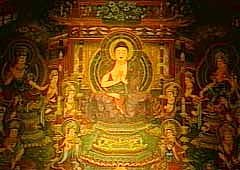
|
|
Chikō Mandala 智光曼荼羅
Gokurakubō Hondō 極楽坊本堂
Gangōji Temple 元興寺, Nara
Painting on Wooden Panel
Early Kamakura Period
Courtesy Asashi (ABC)
|
|
 Chikō (Chiko) Mandala Chikō (Chiko) Mandala
智光曼荼羅. Also referred to as the "First Mandala." The oldest of the Jōdo Sanmandala (three Jōdo mandala) devoted to Amida’s Pure Land. <Below text courtesy JAANUS> It has the simplest composition of the three, for unlike the Taima Mandala and Seikai Mandala, it does not include scenes from the preface of the KANMURYOUJUKYOU 観無量寿経, in the left, right and bottom courts. Traditionally said to have been envisioned by the Sanron 三論 school monk Chikou 智光 (709-ca.790) from Gangouji 元興寺. The miraculous story behide the mandala, related in such texts as Yoshishige Yasutane's 慶滋保胤 NIHON OUJOU GOKURAKUKI 日本往生極楽記 (late 10c) and Eikan's 永観 OUJOU SHUUIN 往生拾因 is as follows: Chikou shared a room with a monk named Raikou 頼光 at Gangouji 元興寺, where they practiced religious devotions. After Raikou died, Chikou prayed for his friend and learned that he had been reborn in Amida's Western Paradise gokuraku joudo 極楽浄土. Chikou longed for rebirth in Amida's Pure Land. Raikou appeared to him in a dream and told him he should practice inner visualization of Amida and his Pure Land; Amida himself showed him how by revealing to him a minature Paradise in the palm of his hand. Upon awakening, Chikou had an artist paint what he had seen. KAKUZENSHOU 覚禅鈔, a collection of iconographical drawings by the Shingon 真言 monk Kakuzen 覚禅 (1143-1212) dating to around 1200, indicates the original mandala was a small painting about 30cm (one shaku 尺) square. This was lost to fire in the Muromachi period. Two extant examples are at Gokurakubou 極楽坊, Gangouji, Nara, are a large (182cm square) wooden panel painting (early Kamakura period) and small painting (30cm square) on silk in a miniature shrine zushi 厨子, Muromachi period 14-15c. <end JAANUS quote>
Dai Mandala 大曼荼羅. Also Daimandala. Literally “Great Mandala.” Classified as a Shishu Mandala, one of four basic artistic/stylistic mandala cateogories, one depicting the deities in physical (human) form. A variant is used by the Nichiren 日蓮 sect. See Hokke Mandala for details.
 Daibutchō Mandala 大仏頂曼荼羅, or Daibutcho Mandala. Other spelling include Dai Bucchō or Daibuccho. Depicts the Nine Butchō (Kubutchō 九仏頂), with eight encircling Dai Butchō 大仏頂 or Shōissai Butchō 摂一切仏頂. The term Butchō, Butcho, or Butchōson 仏頂尊 literally means "Buddha Crown." It refers to a class of Esoteric deities who personify the bump of knowledge (Skt. = Usnisa) atop the Buddha’s head; the Butchō embody the power of the light emitted from that bump; they often appear as Bodhisattva, and can assume male or female form; in Japan, the Butchō are associated especially with rites for the dead, for their powers include purifying evil karma and liberating people from hell. There are different groupings of three, five, eight, nine, and ten Butchō; they sometimes appear in the Shaka-in 釈迦院 section of the Taizōkai Mandala and in the Sonshō Mandala. Daibutchō Mandala 大仏頂曼荼羅, or Daibutcho Mandala. Other spelling include Dai Bucchō or Daibuccho. Depicts the Nine Butchō (Kubutchō 九仏頂), with eight encircling Dai Butchō 大仏頂 or Shōissai Butchō 摂一切仏頂. The term Butchō, Butcho, or Butchōson 仏頂尊 literally means "Buddha Crown." It refers to a class of Esoteric deities who personify the bump of knowledge (Skt. = Usnisa) atop the Buddha’s head; the Butchō embody the power of the light emitted from that bump; they often appear as Bodhisattva, and can assume male or female form; in Japan, the Butchō are associated especially with rites for the dead, for their powers include purifying evil karma and liberating people from hell. There are different groupings of three, five, eight, nine, and ten Butchō; they sometimes appear in the Shaka-in 釈迦院 section of the Taizōkai Mandala and in the Sonshō Mandala.
- Three Butchō (Sanbucchō, Sanbuccho, Sanbutcho, 三仏頂) known as Kōdai 広大 (Skt. = Mahodgatosnisa), Gokukōdai 広大 (Skt. = Abhyudgatosnisa), and Muhen'onjō 無辺音声 (Skt. = Anantasvaraghosa).
- Five Butchō (Gobucchō, Gobutcho, 五仏頂). Byakusangai 白傘蓋 (Skt. = Sitatapatrosnisa), Shō 勝 (Skt. = Jayosnisa), Saishō 最勝 (Skt. = Vijayosnisa), Kōju 光聚 (Skt. = Tejorasyusnisa), and Shajo 捨除 (Skt. = Vikiranosnisa)
- Eight Butchō (Hachibucchō, Hachibutcho, 八仏頂). Three Butchō and Five Butchō; the eight sometimes appear in the Shaka-in 釈迦院 section of the Taizōkai Mandala and in the Sonshō Mandala.
- Nine Butchō (Kubucchō, Kobutcho, 九仏頂). Eight Butchō encircling Dai Butchou 大仏頂 or Shōissai Butchō 摂一切仏頂. See Daibutchō Mandala.
- Ten Butchō (Jūbucchō, Jubutcho, 十仏頂). Nine Butchō and Futsū Butchō 普通仏頂. However, there are variations (e.g., there are different naming conventions for the Butchō, or different enumerations of the eight, nine, or ten).
- Other Bucchō. Ichijikinrin 一字金輪; Shijōkō Butchō 熾盛光仏頂; two others known as Butchō Sonshō 仏頂尊勝 (Skt. = Vijayosnisa) and Byakusangai 白傘蓋 (Skt. = Sitatapatra) became objects of popular individual cults (i.e., both are popular goddesses in Indo-Tibetan Tantrism).
Daibutchō Tsūyō Mandala 大仏頂通用曼荼羅. A type of a Besson Mandala introduced from China to Japan in 805 by Saichō 最澄 (766-822), the founder of the Tendai 天台 sect.
Daihitaizō Sanmaya Mandala 大悲胎蔵三昧耶曼荼羅. Brought from China to Japan by Ennin 円仁 (794-864); a line drawing (no longer extant) closely related to the Taizō Zuzō; a copy dated to 1019 and now preserved at Daigoji Temple 醍醐寺 in Kyōto is considered the oldest extant Japanese copy of such line drawings.
Dakiniten Mandala 荼吉尼天曼荼羅. From the Heian period onward, Dakiniten was invoked in various esoteric rites in Japan to gain complete mastery in human affairs, to hex one's enemies, to win favor at court, to pray for good fortune, and other matters. In Hindu mythology, the Dakini are a class of wrathful female demons who drink blood and eat human flesh, and scholars consider them acolytes of the Hindu goddess Kali. Over time the Dakini were incorporated into Vajrayana (Tantric) traditions as lower-ranking goddesses. In Japan, however, the Dakini group never gained a large following, except for one named Dakiniten (also spelled Dakini-ten). In Japan, Dakiniten is typically depicted riding a fox (often white) and closely associated with food and the rice crop. She is thus, in Japan, often associated or merged with the Shinto rice god Inari (whose messenger is the fox). She also assumes forms related to Daikokuten (lord of five grains). In the 8th-century text Dainichikyousho 大日経疏, Dainichi Buddha appears as Daikokuten in order to subdue Dakiniten 荼吉尼天. She is also closely associated with the esoteric form of the Buddhist goddess Benzaiten. See Tenkawa Benzaiten for more details on Dakiniten.
|
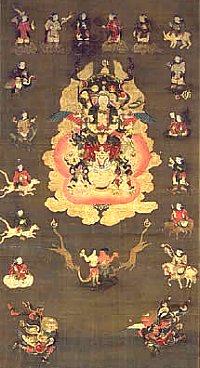
Dakiniten Mandala
荼吉尼天曼荼羅図
12-Armed, Three-Headed Dakini
Early Muromachi Era 室町時代, 15th C
Taho Collection 田万コレクション
H 82.5 cm x W 41.4 cm
Color on Silk
Osaka Municipal Museum of Art
Also known as 三天合形曼荼羅
Lit. "Mandala of Three Deva"
The three heads in above piece are:
Dakiniten 荼吉尼天
Benzaiten 弁財天
Shouten 聖天 (aka Kangiten 歓喜天)
Also known as
三面十二臂辰狐王曼荼羅
Lit. "Mandala of 3-Headed &
12-Armed Dragon-Fox King"
Various syncretic themes are blended in this mandala, including the Oinari 稲荷信 connection (Shintō) with foxes and the Hindu and Buddhist connections with Dakiniten, Kangiten, and Benzaiten. In addition, the museum says a "Black Book" from Hieizan's Myoutoku-in (比叡山明徳院) was found at the back of the mandala, giving it the name 三天合形曼荼羅 (Mandala of Three Deva), and indicating probable Shugendō influence. Most of the figures along the border are “probably” the Jūgo Dōji 十五童子 (Fifteen Sons or Disciples of Benzaiten). See Tenkawa Benzaiten below.
|
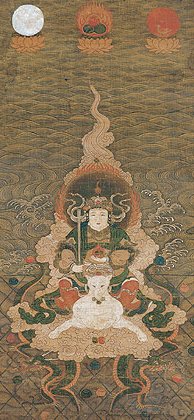
Dakiniten Hangin Scroll
Nambokucho period (1333 AD)
Ink, color, and gold on hemp
29 1/2 x 13 in. (74.9 x 33 cm)
Courtesy
Metropolitan Museum
of Art (New York)
Says Barbara B. Ford at the New York Met: "Originally a blood-sucking man-eating demoness, Dakiniten was converted by the Vairocana (Dainichi) Buddha into a powerful life-engendering deity. In the complex interaction of Buddhism, Shinto, and Taoist yin-yang practices in medieval Japan, this icon embodied near-magical powers of fecundity that were invoked not only in enthronement rituals but also in personal contexts. The mantra identified with this deity was chanted to achieve control over the mind. Medieval tales recount invocations of Dakiniten by both men and women to win position and favor at court, as well as in matters of the heart." <end quote by Barbara B. Ford>
|
|
|
|
Dengyō Daishi 伝教大師 (767 - 822 AD). Also spelled Dengyo Daishi. Literally “Great Master Who Transmitted the Teachings.” It is the posthumous name for Saichō 最澄, the founder of Japan’s Tendai 天台 sect of Esoteric Buddhism (Jp. = Mikkyō 密教). Despite his many contributions, the flowering of mandala artwork in Japan is generally credited to Kūkai (aka Kōbō Daishi) and Shingon traditions. For more details on Saichō, see Tendai Sect below.
Denshingon-in Mandala 伝真言院曼荼羅 at Tōji Temple 東寺 in Kyoto. A famous example of the Ryōkai Mandala; a designated national treasure.
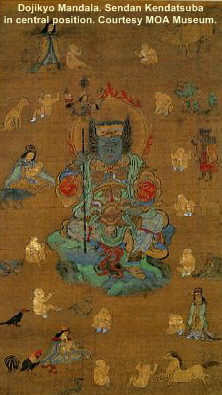 Dōjikyō (Dojikyo) Mandara 童子経曼荼羅. The central figure of the Dōjikyō Mandala 童子経曼荼羅 is Sendan Kendatsuba, who is a guardian of children, one who expels demons of plague, and a king of the Kendatsuba (a class of semi-divine beings who protect Buddhism). The Dōjikyō Mandara was used in esoteric rituals to ward off demons and protect children from illness and danger. Dōjikyō (Dojikyo) Mandara 童子経曼荼羅. The central figure of the Dōjikyō Mandala 童子経曼荼羅 is Sendan Kendatsuba, who is a guardian of children, one who expels demons of plague, and a king of the Kendatsuba (a class of semi-divine beings who protect Buddhism). The Dōjikyō Mandara was used in esoteric rituals to ward off demons and protect children from illness and danger.
Engi Mandala 縁起曼荼羅. Painting that illustrates the story of a Shintō shrine’s foundation.
Enmaten Mandala 閻魔天曼荼羅. Classified as a Besson Mandala, one featuring a single deity from the “Celestial Gods Family,” in this case Enmaten 閻魔天, the lord of death and the underworld known in Sanskrit as Yama and in Chinese as Yanmo Wang 閻魔王. In extant copies of this mandala at Daigoji Temple 醍醐寺 in Kyōto (now preserved by the Kyōto National Museum), Enmaten is depicted with two arms, seated atop a buffalo, and flanked on both sides by two consorts known generally as Kokuangō 黒暗后 (Kokuango; Skt. = Kalaratri) and Shikō 死后 (Shiko; Skt. = Mrtyu). Those names vary, however, for Kokuangō is sometimes known as Enmatengō 閻魔天后 (Skt. = Yami). Ematen’s other retainers come in various flavors, including deities like Shichimoten 七母天 (Skt. = Saptamatrka; literally “Seven Mothers”), various underworld Taoist gods like Taizanfukun 太山府君 (Chn. = Taishanfujun), Shimei 司命, and Shiroku 司録, as well as other deities (of Indian origin) mentioned in the Dainichikyō Sutra 大日経 (Skt. = Vairocanabhisambodhi Sutra). The name of the Lord of Death (Skt = Yama-rāja) is spelled in many different ways, i.e., 閻王, 閻羅, 閻魔王, 閻摩羅, 閻老, 夜摩, 閻羅王, 琰魔, 炎摩, 燄摩, 琰摩, 爓魔. <Source: Soothill>
|
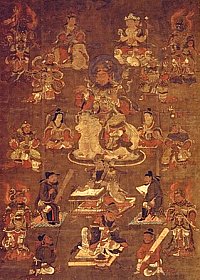
Enmaten Mandala
閻魔天曼荼羅
Kamakura Period
Color on Silk
H 125.1 cm
Important Cultural Property 重文
Photo courtesy this J-site
|
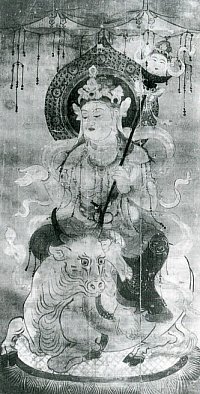
Enmaten Mandala 閻魔天曼荼羅
National Treasure 国宝・文化財大全
Daigoji 醍醐寺 in Kyoto
Other polychrome pieces
kept at Kyoto National Museum
and at Freer Gallery of Art in the US.
Courtesy this J-Site
|
|
Fuji Mandala 富士曼荼羅. <Below entry courtesy JAANUS> Devotional paintings or large pictoral scrolls of Mount Fuji 富士, usually in the form of Sankei Mandara. Fuji mandara show the mountain dominating the painting space. At the bottom of the painting is Miho no Matsubara 三保の松原, the spit of land that stretches across the Suruga 駿河 Bay with pilgrims arriving by boat. Various rituals performed at the foot of the mountain are shown, as is the pilgrim's ascent to the peak. From the 14 century onward, Mount Fuji often was shown as having three peaks, as were other sacred mountains in devotional art. Some paintings show a deity on each peak. The mountain's main shrine -- Asama Jinja 浅間神社 (more commonly pronounced Sengen Jinja) -- was founded in the early 9th century at Fujinomiya 富士宮 (Shizuoka Prefecture) and dedicated to a Shinto God named Konohana-sakuya-hime 木花咲耶姫. However, the names of the shrine and the deity are conflated as is usual in Buddhism. Thus it was also called Asama Daibosatsu 浅間大菩薩 (also read as Sengen Daibosatsu, which can in turn be written 仙元大菩薩), Asama Daimyōjin 浅間大明神, and Fuji Gongen富士権現. By the late 9th century, some pilgrims practiced asceticism on the slopes of Mount Fuji, and in the mid 12th century a chapel to Dainichi Buddha大日如来 was built on the summit by the founder of the mountain's Shugendō 修験道 sect (Shugendo; a major ascetic religious order in Japan). Dainichi's successors flourished and the mountain became a center of popular pilgrimage in the Kamakura and Muromachi periods. In the Edo period, the Fuji cult was further stimulated by the practice of Kakugyō角行 (1541-1646) and Jikigyō食行 (1671-1733), priests who considered the mountain a source of peace and prosperity and who taught a simple, popular faith. Devotional Fuji confraternities (Fujikō 富士講) also spread to Edo and to surrounding provinces, where many believed the mountain would become the paradise of the Future Buddha (aka Miroku 弥勒), who in turn would create an age of prosperity and justice. Fuji Mandara were used for the diffusion of the Fuji cult, showing the area as a destination for religious pilgrimage, as well as a memento of the famous spot. Extant examples date from the late Muromachi period (15th century). <end JAANUS quote>
Fushū-e (Fushu-e) Mandala 普集会曼荼羅. A type of Toe Mandala showing various deities from numerous deity families; described in the Darani Jikkyō 陀羅尼集経 (Taishō No. 901).
Genzu Mandala 現図曼荼羅. A version of the Taizōkai Mandala 胎蔵界曼荼羅 (Womb World, Matrix Mandala) still widely used and replicated by Japan's Shingon 真言 and Tendai 天台 sects. It was brought to Japan from China by Kūkai 空海 (Kukai; 774-835), who studied under the Chinese Master Huiguo 恵果 (Jp. = Keika; 746-805). Huiguo is credited with the finalized Genzu format, which stemmed from descriptions of the Taizōkai Mandala in the Dainichikyō Sutra 大日経 (Skt. = Vairocanabhisambodhi-sutra / Mahavairocana-sutra). Although the Genzu format can vary somewhat, it generally includes around 414 deities arranged systematically into 12 sections. That is a massive increase from the approximately 120 deities mentioned in the Dainichikyō Sutra, the 242 deities appearing in the Taizō Kyūzuyō, and the 324 deities appearing in the Taizō Zuzō. The latter two predate the Genzu Mandara, which is thought to have evolved from them. The Genzu format is typically divided into 12 sections that depict specific deities and deity families. See Quick Quide for Listing of All Twelve.

Gobu Shinkan 五部心観. Extant hand-scroll line drawings depicting the deities of the Kongōkai (Diamond) Mandala, but in a format that differs from the orthodox Kongōkai layout; brought to Japan by Enchin 円珍 (814-91); it's full title is Ritasōgyara Gobu Shinkan 哩多僧蘖五部心観; the original is kept at Onjōji Temple 園城寺 in Shiga Preference.
Gohonzon 御本尊. Also spelled Go-Honzon. A mandala used by the Nichiren sect and based on the Lotus Sutra. See Hoke Mandala for details.
Hachiji Monju Mandala 八字文殊曼荼羅. Eight-Letter Monju Mandala. Classified as a Besson Mandala, one featuring the "Bodhisattva Family," for the central deity in this case is a form of Monju Bodhisattva. See photo above at right.
|
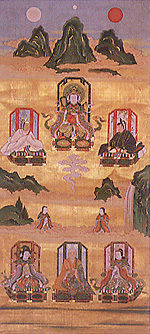
|
|
Hakusan Gongen Painting
白山大権現神
Treasure Nagataki Hakusan
長滝白山神社・白山長滝寺
Three peaks of Hakusan and their mountain avatars typically appear in such paintings, as does Taichō 泰澄 (d. 8th c), founder of the Hakusan cult.
|
|
 Hakusan Mandala 白山曼荼羅 Hakusan Mandala 白山曼荼羅
and Hakusan Shichi Gongen 白山七権現.
Classified as a type of Miya Mandala. Hakusan was a sacred mountain site from early times, a center of syncretic Shinto-Buddhist beliefs and the Shugendō 修験道 cult of mountain worship. It is located along the borders of four prefectures (Fukui, Gifu, Ishikawa, and Toyama). From the 12th century onward, it was ruled by Enryakuji Temple 延暦寺 on Mt. Hiei 比叡 in Kyoto Prefecture, and thus copied the 21-shrine format (7-7-7 pattern) of the Sannō 山王 shrines at Mt. Hiei (see Hiei Mandala).
The main deity is Shirayama-hime 白山比売 and her shrine-temple is known as Hakusan Hongū 白山本宮 (or Hakusanji 白山寺). Her group of seven shrines is the main group, and its seven deities are called the Hakusan Shichi Gongen 白山七権現 (Seven Avatars of Mt. Hakusan). There is another grouping of three called the Hakusan Sansho Gongen 白山三所権現, and they are thought to represent the three deities of the three mountains Bessan 別山, Gozenpō 御前峰, and Oonanjimine 大汝峰. The Buddhist counterparts (honjibutsu 本地仏) of the three are sometimes given as Shō Kannon 聖観音, Jūichimen Kannon 十一面観音 and Amida 阿弥陀, but this can vary depending on the source.
For many more details on sacred Mt. Hakusan, please see our Hakusan Mountains & Deities Page. For more on the Hakusan Mandala, please see JAANUS.
Hannya Bosatsu Mandala 般若菩薩曼荼羅. This is the abbreviated name for Hannya Haramitsu 般若波羅蜜 or Hannya Haramitta 般若波羅蜜多, a female bodhisattva of India providence who personifies the Hannya Haramitsu (Skt. = Prajna Paramita). This latter Sanskrit term refers to the process of “perfecting wisdom.” By extension, it refers to the Mahayana sutra known as the Hannyakyō 般若経 (Skt. = Prajnaparamita Sutra), which describes a six-fold path for overcoming delusion, perfecting wisdom, and achieving enlightenment. In this sense, “wisdom” equates with “enlightenment,” and thus this female deity is also called Butsumo 仏母 (literally “Mother of the Buddha;” also see Butsugen Mandala. She is depicted in various forms, but most commonly shown holding her namesake sutra. In Japan she is sometimes invoked instead of Shaka 釈迦 (the Historical Buddha) during the Daihannya-e 大般若会, a ritual reading of the 600-fascicle translation of her sutra, and one that included veneration of the Hannya Mandara, in which she is typically shown alone or surrounded by the 16 Good Deities (Jūroku Zenjin 十六善神). The latter are said to protect people who recite her sutra. In Japan, Hannya Bosatsu is rarely represented at the center of a mandala.
|
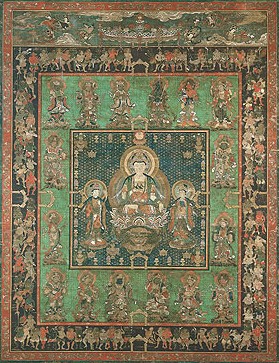
|
|
Japanese Mandala of Hannya Bosatsu
16th century; Muromachi period (1392 - 1573)
Hanging scroll; ink, color, and gold on silk
Image 64 1/2 x 48 5/8 in. (163.9 x 123.5 cm)
|
|
 Hie Sannō Mandala (Hie Sanno) 日吉山王曼荼羅. Devotional paintings from the shrine-temple Tendai 天台 multiplex known as Hie Sannōsha 日吉山王社 (also called Hiyoshi Sannōsha) located at Mt. Hiei 比叡 in Sakamoto 坂本, Shiga Prefecture. When Monk Saichō 最澄 (Saicho, 766-822) returned from his studies in China, he gave the local Shintō deity Ōyamagui 大山咋 the name Sannō; the name is thought to derive from the Chinese god who protects China's Mount Tientai 天台 (Jp. = Tendai). In Japan, Sannō 山王 (lit. Mountain King) takes the form of a monkey avatar known as Sannō Gongen 山王権現. Extant paintings date from the middle 13th century. There are related paintings known as Hie Sannō Matsuri 日吉山王祭 or Sannō Matsuri 山王祭, which illustrate the Hie Shrine’s annual festival devoted to the monkey avatar. The Hie shrine-temple multiplex is one of the three most important syncretic Shintō-Buddhist sites in Japan, along with the Kumano 熊野 complex in southern Wakayama Prefecture (see Kumano Mandala) and the Kasuga 春日 shrines near Nara (see Kasuga Mandala). The Hie shrine-temple multiplex was already an important center of Shinto-Buddhist syncretism in Japan in the mid-Heian period, when it became a popular site among nobles and commoners alike. Its central deity is SANNŌ, whose messenger (tsukai 使い) and avatar (権現) is the monkey. The Sannō deity is broadly conceived, for Sannō actually represents three Buddha (Shaka, Yakushi, and Amida), who in turn represent the three most important Shintō KAMI (deities) of the Hie complex (Omiya 大宮, Ninomiya 二宮, and Shōshinshi 聖真子). All six are considered manifestations of the Sannō deity. By the Kamakura period, the multiplex was composed of 21 shrines (Sannō Nijūissha 山王二十一社), which were associated with 21 Sannō deities, which in turn were associated with 21 specific Buddhist counterparts. The many manifestations of the Sannō deity are called "Hie Sannō Gongen" (日吉山王権現 Mountain King Avatars of Hie Shrine). The 21 shrines are split into three groups of seven -- the three groupings represent the three main Buddha-Kami pairings of the Tendai complex. The so-called Upper Seven Sannō Shrines (Sannō Kami no Shichisha 山王上七社) form the core of the Sannō complex. Known as the Big Hiei group, they are associated with Shaka and with the seven stars of the Big Dipper. The next group of seven shrines, known as The Little Hiei group, is associated with Yakushi Nyorai. The Hiyoshi Sannō Mandala 日吉山王曼荼羅 at Reiunji Temple 霊雲寺 in Tokyo (a designated national treasure dated to the Kamakura period) depicts the landscape, structures, and syncretic deities of the 21 shrines at Mt. Hiei, and shows a monkey as well. As such, it can be considered a type of Suijaku Mandala. However, says scholar MASUTO TOYOOKA, the mandala was long misidentified as a Yoshino Mandala (see photo in Yoshino Mandala section). However, its close resemblance to another extant painting of the Hiyoshi-Sannō deities (at Kudaraji Temple 百済寺 in Shiga 滋賀 Prefecture) helped convince scholars of its mistaken designation. Hie Sannō Mandala (Hie Sanno) 日吉山王曼荼羅. Devotional paintings from the shrine-temple Tendai 天台 multiplex known as Hie Sannōsha 日吉山王社 (also called Hiyoshi Sannōsha) located at Mt. Hiei 比叡 in Sakamoto 坂本, Shiga Prefecture. When Monk Saichō 最澄 (Saicho, 766-822) returned from his studies in China, he gave the local Shintō deity Ōyamagui 大山咋 the name Sannō; the name is thought to derive from the Chinese god who protects China's Mount Tientai 天台 (Jp. = Tendai). In Japan, Sannō 山王 (lit. Mountain King) takes the form of a monkey avatar known as Sannō Gongen 山王権現. Extant paintings date from the middle 13th century. There are related paintings known as Hie Sannō Matsuri 日吉山王祭 or Sannō Matsuri 山王祭, which illustrate the Hie Shrine’s annual festival devoted to the monkey avatar. The Hie shrine-temple multiplex is one of the three most important syncretic Shintō-Buddhist sites in Japan, along with the Kumano 熊野 complex in southern Wakayama Prefecture (see Kumano Mandala) and the Kasuga 春日 shrines near Nara (see Kasuga Mandala). The Hie shrine-temple multiplex was already an important center of Shinto-Buddhist syncretism in Japan in the mid-Heian period, when it became a popular site among nobles and commoners alike. Its central deity is SANNŌ, whose messenger (tsukai 使い) and avatar (権現) is the monkey. The Sannō deity is broadly conceived, for Sannō actually represents three Buddha (Shaka, Yakushi, and Amida), who in turn represent the three most important Shintō KAMI (deities) of the Hie complex (Omiya 大宮, Ninomiya 二宮, and Shōshinshi 聖真子). All six are considered manifestations of the Sannō deity. By the Kamakura period, the multiplex was composed of 21 shrines (Sannō Nijūissha 山王二十一社), which were associated with 21 Sannō deities, which in turn were associated with 21 specific Buddhist counterparts. The many manifestations of the Sannō deity are called "Hie Sannō Gongen" (日吉山王権現 Mountain King Avatars of Hie Shrine). The 21 shrines are split into three groups of seven -- the three groupings represent the three main Buddha-Kami pairings of the Tendai complex. The so-called Upper Seven Sannō Shrines (Sannō Kami no Shichisha 山王上七社) form the core of the Sannō complex. Known as the Big Hiei group, they are associated with Shaka and with the seven stars of the Big Dipper. The next group of seven shrines, known as The Little Hiei group, is associated with Yakushi Nyorai. The Hiyoshi Sannō Mandala 日吉山王曼荼羅 at Reiunji Temple 霊雲寺 in Tokyo (a designated national treasure dated to the Kamakura period) depicts the landscape, structures, and syncretic deities of the 21 shrines at Mt. Hiei, and shows a monkey as well. As such, it can be considered a type of Suijaku Mandala. However, says scholar MASUTO TOYOOKA, the mandala was long misidentified as a Yoshino Mandala (see photo in Yoshino Mandala section). However, its close resemblance to another extant painting of the Hiyoshi-Sannō deities (at Kudaraji Temple 百済寺 in Shiga 滋賀 Prefecture) helped convince scholars of its mistaken designation.
Himitsu Mandala 秘密曼荼羅. Secret Mandara. See Sanmaya (Samaya) Mandala.
Hiyoshi Sannō Mandala (Hiyoshi Sannosha) 日吉山王社. See Hie Sannō Mandala.
Hō (Ho, Hou) Mandala 法曼荼羅. See Shuji Mandala.
|
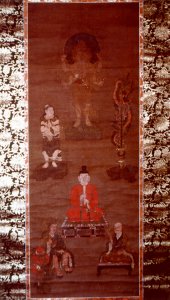
|
|
Hōki Mandara 法起菩薩曼荼羅
Photo courtesy this J-Site
Says Gabi: This Hoki Bosatsu has six arms and five eyes. He stands on a rock with a wrathful face. This is possibly the only painting of the deity. Perhaps painted by Tayuu Hoogen Saiken in the 15th century. This painting is an important cultural property of Sakai Town, Osaka.
|
|
Hōki Bodhisattva Mandala 法起菩薩曼荼羅.
Hōki (also spelled Hoki, Houki) is a relatively unknown Japanese bodhisattva. The characters for Hōki 法起 are exactly the same as the characters of Hōkiji Temple 法起寺 (reportedly established by Shōtoku Taishi’s son in the foothills northeast of Hōryūji Temple in Nara in the early 7th century). Hōki could be loosely translated as "arising dharma" or "awakening knowledge." A secret image 秘佛 of this deity is found at Bodaiji Temple 菩提寺 in nearby Hyōgo Prefecture. Says site contributor Gabi Greve: "This Bosatsu is not very familiar, but he is one of the protector deities of mountain ascetics, ranging back to the time of En no Gyōja 役行者, the latter the most famous Japanese mountain holy man of the 7th century.
Hōki Bosatsu is sometimes depicted with five eyes and six arms 五眼六臂. He is also considered an incarnation of Hōdō Sennin 法道仙人, an Indian ascetic who, according to well-known legends, lived in the 7th century during the time of Emperor Suiko and Shōtoku, and walked all the way through China and Korea until he reached Japan. He walked with his companion, the God of the Bulls, Gozu Tenō 牛頭天王. Hōdō Sennin is very popular in the area around Himeji in Hyōgo Prefecture, which is also an area with strong connections to Shōtoku legends. Hōdō Sennin is said to have founded BodaiJi Templeand a few others in this region." <end Gabi Greve quote> The link between Hōkiji Temple and Hōki Bosatsu is unknown, but Hōki Bosatsu is clearly an esoteric deity, and Hōkiji Temple was affiliated with the Shingon sect of esoteric Buddhism for a short time. Also, Shōtoku maintained many associations with the Shinto cults of his day, and it is an least plausible that Hōkiji Temple may be in some way associated with Japan's early mountain cults.
|
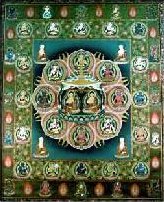
|
|
Hokke Mandala 法華曼荼羅
Courtesy Mt. Koya, Japan
At Hōjuin Temple 宝寿院
Mt. Kōya 高野, Wakayama Pref.
In above format, Shaka 釈迦
(Historic Buddha) and Tahō 多宝如来 (related to the future) are seated in a jeweled pagoda.
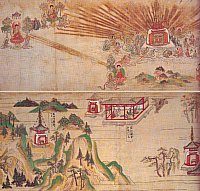
Lotus Sutra, Narrative Scrolls
Photos from De Jong Collection
Click images above for larger image.
13th Century, Kousetsu Art Museum.
13th Century, Hatakeyama Museum.
Both are Important Cultural Properties.
|
|
 Hoke (Hokke) Mandala 法華曼荼羅 Hoke (Hokke) Mandala 法華曼荼羅
Lotus Mandala. Also called Hokkekyō Mandala 法華経曼荼羅, Hokekyō Hōtō Mandala 法華経宝塔曼荼羅, and Hokkekyō Hensō 法華経変相. A class of Besson Mandala that features the “Sutra-Rite Family” of Deities. The Hokke Mandara comes in various flavors. For example, a common format depicts a great assembly of disciples, Bodhisattva, divine beings, and celestial creatures who have gathered to hear the Buddha expound the teachings of the Lotus Sutra.
Another format is a pictorial illustration of these teachings, more properly called the Hokkekyō Mandala (Lotus Sutra Mandala). In Japan’s Esoteric sects, the Hokke Mandala serves as an object of veneration in Lotus Sutra Rites (Hokkekyō-Hō 法華経法).
Among devotees of the Nichiren 日蓮 sect, the Lotus Sutra itself is the main object of worship (Gohonzon 御本尊), and followers pay homage to a special mandala on whose sides are written numerous deity names and in the center is written: Namu-myōhō-ren-ge-kyō 南無妙法蓮華経, the core invocation of believers. It translates as “Homage to the Great Dharma of the Lotus Blossom Sutra.” This type of mandala comes in various forms and is more properly called:
- Dai Mandala 大曼荼羅 (Great Mandala)
- Kanjōjikkai Mandala 勧請十界曼荼羅
Invoking Ten Realms Mandala
- Jikkai Kanjō Mandala 十界勧請曼荼羅
Invoking Ten Realms Mandala
- Jikkai Mandala 十界曼荼羅
Ten Realms Mandala
See photos immediately below.
|
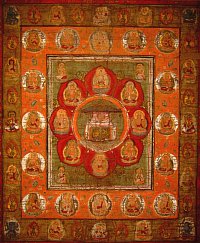
Hokke Mandala 法華曼荼羅
Hōryūji Temple 法隆寺
Heian Period, Color on Silk
H 71.7 cm W 59.3 cm
Courtesy Treasures of Nara
From early on, the Lotus Sutra was one of Japan’s most popular & influential texts. Its promise of universal salvation, even for those suffering in hell (the lowest of ten realms) brought hope to all. The popularity of deities like Kannon & Fugen stems, in part, from their appearance in the sutra. The 10 realms (low to high; Japanese readings):
- Hells (Jigoku 地獄)
- Hungry Ghosts (Gaki 餓鬼)
- Animals (Chikushō 畜生)
- Bellicose Demons (Ashura 阿修羅)
- Humans (Ningen 人間)
- Heavenly Beings (Ten 天)
- Sravaka Arhats (Shōmon 声聞); listeners of Buddhist teachings
- Pratyeka Buddhas (Engaku 縁覚); self-enlightened beings
- Bodhisattvas (Bosatsu 菩薩); compassionate ones
- Buddhas (Nyorai 如来, Hotoke 仏l)
|
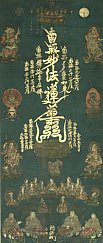
Mandala for Invoking the Ten Realms
Jikkai Kanjō Mandala 十界勧請大曼荼羅
Nanbokuchō Era 南北朝 (1368 AD)
Honkyōji Temple 本境寺, Fukui Pref.
Courtesy this J-site
This type of Hokke Mandala is
attributed to Nichiren 日蓮 (1222-82).
Large characters in center
represent the core invocation:
Namu-myōhō-ren-ge-kyō
南無妙法蓮華経
Ten Realms Mandala
Deities from all ten realms (see list at left) are depicted in such mandala. Some of the deities and beings in above piece are:
|
|
|
|
Hokuto Mandala 北斗曼荼羅. Big Dipper Mandala. Used when performing the Hokutohō 北斗法 or "Big Dipper Rite" for averting natural disasters and calamity. Classified as a type of Hoshi (Star) Mandala. Also classified as a Besson Mandala dedicated to specific deities. This mandara’s most popular appearance in Japan is centered around Shaka Kinrin 釈迦金輪 (Gold Wheel Shaka). Shaka Kinrin is a manifestation of Shaka Buddha 釈迦如来 (the Historical Buddha), one in which Shaka is holding a golden wheel in his hands, with the latter placed on the lap and the hands forming the Hokkai Jōin Mudra 法界定印 (dharma-realm meditation mudra). Ichijikinrin Butchō (see Ichijikinrin Mandala) can sometimes assume the form of Shaka Kinrin 釈迦金輪. In the Hokuto Mandara, Shaka Kinrin is often shown surrounded by the Big Dipper’s seven stars, by the nine planets, by the 12 signs of the Zodiac, and by the deities of the 28 lunar mansions. The Tendai 天台 sect uses a circular mandara (a renowned example is preserved at Hōryūji Temple 法隆寺 in Nara, while the Shingon 真言 Sect uses a square mandara (preserved at Kumedadera 久米田寺 in Osaka). See photos of both below. The disposition of the deities varies somewhat. See also Tōhon Hokuto Mandala, which is devoted to Shijōkō Butchō 熾盛光仏頂.
|
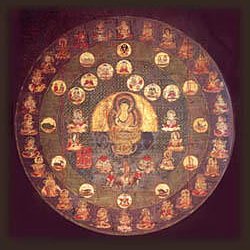
Hokuto Mandala 北斗曼荼羅
Heian (Fujiwara) Period
Circular version, Hōryūji Temple 法隆寺, Nara
Kakemono. Color and gold leaf on silk. L = 118.2 cm, W = 83.3 cm
28 deities in outer circle, 12 zodiac signs in middle circle,
days and planets in inner circle, and main deity
Ichijikinrin Butchō 一字金輪仏頂 at center.
Ichijikinrin (aka Shaka Kinrin) is an emanation of
Shaka Nyorai (Historical Buddha). Photo courtesy this J-site
Considered the greatest of extant paintings of the Star Mandala. Such mandala, either round or square, were used when petitioning for relief from disasters or to pray for longevity. Says the Kyoto National Museum: “These days it is more common to tell fortunes from the twelve signs of the zodiac, but in the old days it was more common to tell fortunes from the seven stars of the Big Dipper. Your fate depended on which of the seven stars was ruling on the month and day you were born. The ruling star on the day the fortune telling is performed was also important. The sun, moon and planets and the twenty-eight signs played secondary roles to the seven stars of the Big Dipper. People prayed to these stars to help prevent disasters and to live longer.”
|
|
|
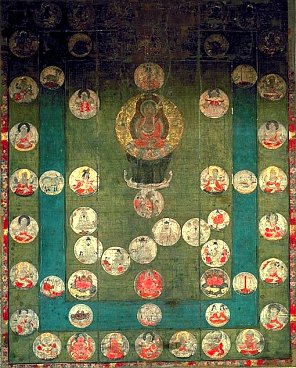
Hokuto Mandala 北斗曼荼羅, Heian Period
Square version, Kumedadera Temple 久米田寺, Osaka
28 deities in outer circle, 12 zodiac signs in middle circle,
days and planets in inner circle, and main deity
Ichijikinrin Butchō 一字金輪仏頂 at center.
Ichijikinrin (aka Shaka Kinrin) is an emanation of
Shaka Nyorai (Historical Buddha). Photo courtesy this J-site
Says the Kyoto National Museum: Under the central Buddha are seven medallions shaped like an "S" turned on its side, or a scoop. Inside each medallion is a figure wearing a headdress. These are the Seven Stars of the Big Dipper, the most important stars in the Star Mandala. They are shaped like this to represent the constellation of the big dipper. Other medallions in the center section represent planets such as Mercury, Venus and Saturn, and the Sun and Moon.
|
|
Honjaku Mandala 本迹曼荼羅 (shows Shinto & Buddhist deities in relation to one another). See Kasuga Mandala.
Honji Mandala 本地曼荼羅.See Kasuga Mandala or Suijaku Mandala.
Honjibutsu Mandala 本地仏曼荼羅 (shows only the Buddhist deities). See Kasuga Mandala.
Honji Suijaku Mandala 本地垂迹曼荼羅. Mandala of True and Manifest Deities. Also known as the Songyō Mandala. See Kasuga Mandala for a few more details.
Hōrōkaku (Horokaku) Mandala 宝楼閣曼荼羅. Based on the Jeweled Pavilion Sutra 宝楼閣経 of Indian providence, hence the name. There are considerable discrepancies among surviving copies, but generally the mandala depicts a pavilion wherein Shaka Buddha 釈迦如来 (the Historical Buddha) is seated. On his right is the four-faced, twelve-armed Kongōshu Bodhisattva 金剛手 (Kongoshu, Skt. = Vajrapani). On the left is the four-faced, sixteen-armed Hōkongō Bodhisattva 宝金剛 (Hokongo, Skt. = Manivajra). Around them are the Four Heavenly Kings (Shitennō, Shitenno, 四天王) and other protective deities.
Hoshi Mandala 星曼荼羅. Literally Star Mandala. Sometimes referred to as Hokuto Mandala. A type of Besson Mandala dedicated specifically to one deity who is surrounded by numerous celestial divinities – those symbolizing the stars, planets, and other heavenly bodies. The iconography of Japanese religious art includes numerous planets, stars, constellations and other heavenly bodies that were deified and incorporated into Buddhism. They include the nine planets (Kuyō/ Kuyo 九曜 or Kushitsu 九執), the sun and moon, the twelve houses of the Zodiac 十二宮 (Juniku or Juunikyū), the 28 Lunar Mansions 二十八宿 (Nijūhasshuku, Nijuhasshuku), the Polestar / Big Dipper (see Myōken Mandala), and others. The Japanese term Seishukubu 星宿部 (sidereal division) is sometimes used to categorized this diverse group of celestial deities. The main types of Star Mandala are:
- Hokuto Mandala. Centered around Shaka Kinrin 釈迦金輪 (Gold Wheel Shaka), a manifestation of Shaka Buddha 釈迦如来 (the Historical Buddha); also known as the Big Dipper Mandala.
- Kara-zu 火羅図. Star drawings that resemble a horoscope.
- Myōken Mandala 妙見曼荼羅; centered on Myōken (Myoken) Bodhisattva, a deification of the pole star.
- Shichishō Nyoirin Mandala 七星如意輪曼荼羅; literally Seven-Star Nyoirin Mandala (other spellings: Shichisho, Shichishou); devoted to Nyoirin Kannon 如意輪観音; see Nyoirin Mandala for more details.
- Shūnanzan Mandala 終南山曼荼羅; reflects Taoist influences.
- Tōhon Hokuto Mandala 唐本北斗曼荼羅; of Chinese origin and devoted to Shijōkō Butchō (Shijoko Butcho) 熾盛光仏頂.
Ichijikinrin Mandala 一字金輪曼荼羅
|
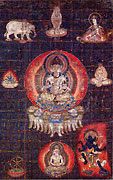
|
|
Ichijikinrin Mandala
Courtesy Mt. Koya, Japan
At Henjōkōin 遍照光院
Mt. Kōya 高野
Wakayama Pref.
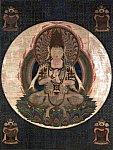
Ichiji Kinrin Butchou
Skt. Ekaaksarausnisa cakra
AKA DAINICHI BUDDHA
Courtesy Tokyo Nat’l Museum
Formerly owned by the Hara Family.113.9 x 86.0
Kamakura Period, 13th century
|
|
Also spelled Ichiji Kinrin. A type of Besson Mandala, but one featuring the Buddha-Crown Family (Butsubu 仏部) and centered on the deity Ichijikinrin Butchō 一字金輪 (One-Syllable Gold Wheel). Ichijikinrin is also known as Ichijikonrin, Kinrin Butchō 金輪仏頂 (Gold-Wheel Buddha Crown), Kidoku Butchō 奇特仏頂 (Marvellous Buddha Crown), or Ichijichōrin-ō 一字頂輪王 (Wheel King of the One-Syllable Crown; Skt. = Ekasarosnisa Cakravartin). Ichijikinrin personifies the single-syllable Sanskrit term “bhrum” (Jp. = Boron 勃ろん). This holy word is said to embody the virtues of all Buddha and Bodhisattva. Ichijikinrin is considered supreme among the Butchō (see Daibutchō Mandala for more details on Butchō deities). Kinrin 金輪 means Gold Wheel. It is one of the seven treasures, the most important of the four wheels of motion, and a sign of the universal ruler, or "Wheel King" (Rinō 輪王 or Tenrinjō-ō 転輪聖王; Skt. = Cakravartin). In the Ichijikinrin Mandala, Ichijikinrin is shown in the center with hands in the Chiken-in Mudra 智拳印 (knowledge-fist mudra). Although extant examples differ, Ichijikinrin is generally surrounded by seven treasures (Shippō七宝, Skt. = Saptaratna), which in the Sino-Japanese tradition are considered marks of the universal ruler. Butsugen Butsumo 仏眼仏母 sometimes appears in extant mandala of this type. Ichijikinrin appears in two main forms. As Dainichi Kinrin 大日金輪 (as in the Ichijikinrin Mandala), he is similar in appearance to Dainichi Buddha 大日如来. His hands form the wisdom-fist mudra and he is typically shown sitting within a solar disc. In the Hokuto Mandala (Big Dipper Mandala), however, he assumes the form of Shaka Kinrin 釈迦金輪.
Ise Sankei Mandala 伊勢参詣曼荼羅. Devotional paintings (sometimes also narrative illustrations) of the shrines of Ise Jingū 伊勢神宮, a revered Shintō site in Japan. Such mandala serve also as guides for people who cannot actually visit the holy Ise shrines. Only a few pieces are still extant, but most depict the main inner and outer sanctuaries, pathways, structures, and divinities within. A type of Miya Mandala, and similar as well to a Shaji Sankei Mandala. However, unlike Miya-type mandara (which are often static representations of a shrine layout), Sankei Mandala tend to present a dynamic aspect, one that describes the activities undertaken by shrine (or temple) visitors, and thus they are commonly filled with figures of people moving through the sacred space. < SOURCE: Ise Sankei Mandara by Peter Knecht in Japanese Journal of Religious Studies, 2006. >
|
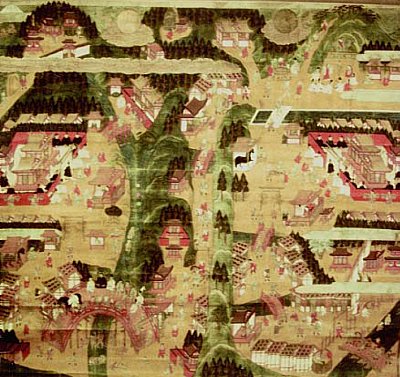
Ise Sankei Mandara 伊勢参詣曼荼羅, Photo and story by Peter Knecht
Ise Sankei Mandara & Image of the Pure Land
Japanese Journal of Religious Studies 33/2: 223–248, © 2006 Nanzan Institute for Religion & Culture
Says scholar Knecht: Unless one also journeys to Mount Asama 朝熊山 and the large temple Kongō Shōji 金剛証寺, any journey to the Ise Shrines is "only half a pilgrimage.”
|
|
Jikkai Mandala 十界曼荼羅. Ten Realms Mandala. Attributed to Nichiren日蓮. See Hokke Mandala for details.
Jōdo Mandala 浄土曼荼羅 (Jodo Mandala; also known as Jōdo Hensō-zu 浄土変相図). Paintings depicting the paradises and non-Trantric deities of Japan's Pure Land sects (浄土宗). The most popular pure land in Japanese Buddhism is associated with Amida Nyorai 阿弥陀如来and Amida's Western Paradise (Jp. = Saihō Jōdo 西方浄土; also called Amida Jōdo Hensō 阿弥陀浄土変相, Gokuraku極楽, Skt. = Sukhavati). However, the pure lands of Mahayana Buddhism also include those of Yakushi Buddha 薬師, Shaka Buddha 釈迦, and Miroku Bodhisattva 弥勒. Kannon Bodhisattva 観音is often included in Pure Land paintings associated with Amida’s Pure Land. There are numerous variations on the Jōdo Mandara, but generally speaking, Amida in shown in the center and is flanked on both sides by attendants, usually Seishi Bodhisattva and Kannon. In addition, Amida artwork often depicts Amida surrounded by 25 Bodhisattva (including Kannon and Seishi) descending from heaven to guide departed souls back to paradise. Finally, mandala devoted to Amida’s Pure Land are often designated with a special writing convention for the term “mandala.” Instead of the typical 曼荼羅 characters, the term is written as 曼陀羅 – the middle kanji, 陀, is the same as the last character in Amida’s 阿弥陀 name.
|
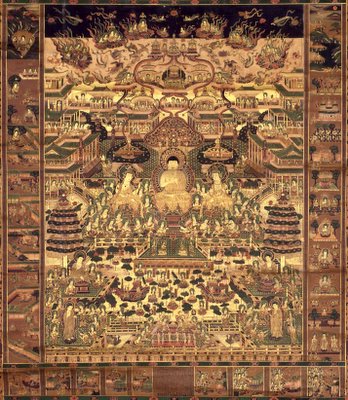
Jodo Mandala Depicting Amida’s Western Paradise
当麻曼荼羅図 紙本著色 縦104.2 横89.6 江戸中期(18世紀) 長保寺蔵
Courtesy: www.chohoji.or.jp
|
|
Jōdo Sanmandara 浄土三曼荼羅. Also Jodo Sanmandala; lit. = Three Mandalas of the Pure Land. <Below text courtesy JAANUS> Traditionally refers to the three most famous types of Jōdo Hensō 浄土変相 (Depictions of the Pure Land) which are the Chikō Mandala 智光曼荼羅, Taima Mandala 当麻曼荼羅, and Seikai Mandara 清海曼荼羅 (also read Shōkai Mandara). The Chikō Mandala is traditionally said to have been first painted after a vision by the Gangōji Temple 元興寺 monk Chikō 智光 in the Nara period (8c); a copy is found in the KAKUZENSHOU 覚禅鈔, a collection of iconographical drawings by the Shingon monk Kakuzen 覚禅 (1143-1212). The Chikō Mandala refers to a tapestry belonging to Taimadera Temple 当麻寺 in Nara, which is thought to have been imported from China and is said to have been dated by inscription to 763. The Seikai Mandara, painted in gold and silver on indigo-dyed silk, is said to represent a vision of the monk Seikai 清海 and has been dated to 996. Both the Taima and Seikai mandaras are based on the Kanmuryōjukyō Sutra 観無量寿経, and may also be called Kangyō Hensō 観経変相 (Transformation Scenes of the Pure Land). <end JAANUS quote>
Jūuniten (Jyuniten) Mandala 十二天曼荼羅図. Mandala of The Twelve Celestials. At Kongōbuji Temple 金剛峯寺 (Mt. Kōya 高野 in Wakayama Prefecture). Also see Anchin Mandala for another photo depicting the Twelve Celestials.
Kanjō Jikkai Mandala 勧請十界曼荼羅. Kanjojikkai Mandara. Mandala for Invoking the Ten Realms. Devised by Nichiren日蓮 (1222-82), the founder of Japan’s popular Nichiren sect. Also written Jikkai Kanjō Mandala 十界勧請曼荼羅. See Hokke Mandala for details.
Kara-zu 火羅図. A type of Hoshi (Star) Mandala that resembles a horoscope. See photo at right.
Kashimadachi Mandala 鹿嶋立曼荼羅or Kashimadachi Shen'ei-zu鹿嶋立神影図. See Kasuga Mandala.
Kasuga Fudarakusen Mandala 春日補陀落山曼荼羅. See Kasuga Mandala.
Kasuga Jōdo (Jodo) Mandala 春日浄土曼荼羅. See Kasuga Mandala.
Kasuga Mandala 春日曼荼羅. Devotional paintings of the deities and scenery of Kasuga Taisha 春日大社, an important 8th-century shrine founded in Nara by the Fujiwara 藤原 clan which had close affiliations with the Buddhist temple Kōfukuji 興福寺. The temple’s deities and landscapes are thus sometimes portrayed in the mandala as well. The Kasuga Shrines are located at the foot of sacred Mt. Mikasa 御蓋山 in the hills surrounding the city of Nara. Kasuga is one of the three most important syncretic Shintō-Buddhist sites in Japan, along with the Kumano 熊野 complex in southern Wakayama Prefecture (see Kumano Mandala) and the Sannō 山王 shrine-temple multiplex near Kyoto (see Hie Sannō Mandala). Three main types of Kasuga Mandala can be distinguished. The first is the Miya Mandala 宮曼荼羅, which depicts the shrine and its landscape. A variation of this type is the Shaji Mandala 社寺曼荼羅, which includes images of Kōfukuji Temple as well. Another variation is the Kōfukuji Mandara 興福寺曼荼羅, wherein artwork of the temple overshadows that of the shrine. The second type is the Shika Mandala 鹿曼荼羅 (literally Deer Mandala). It features images of the deer (the sacred animal of Kasuga Shrine), often paired with the sacred Sakaki 榊 tree (Latin = Cleyara ochnacea). The Shika Mandala sometimes shows a sacred mirror as well. A well-known variation is called Kashimadachi Mandala 鹿嶋立曼荼羅 or Kashimadachi Shen'ei-zu 鹿嶋立神影図. It depicts the kami (deities) of Kashima 鹿嶋 (modern Ibaraki prefecture) riding a deer on the way to Kasuga. One of the two kami typically portrayed is Takemikazuchi no Mikotoi 武雷神. The third type is the Honji Suijaku Mandala 本地垂迹曼荼羅 or Songyō Mandala 尊形曼荼羅. It includes depictions of the Shintō kami (deities) and their Buddhist counterparts (Honjibutsu 本地仏). This third group includes numerous sub-types, including the Honjaku Mandala 本迹曼荼羅 (shows Shintō and Buddhist deities in relation to one another, the Honjibutsu Mandala 本地仏曼荼羅 (shows only the Buddhist deities), the Suijaku Mandala 垂迹曼荼羅 (shows only the individual kami), and Paintings of Akadōji 赤童子 (Red Youth). Paintings that depict Kasuga Shrine as a paradise are yet another category. These are called Kasuga Jōdo Mandara春日浄土曼荼羅 and Kasuga Fudarakusen Mandara 春日補陀落山曼荼羅. <See JAANUS Kasuga entry for more details>
|

Mandala of Kasuga Shrine Deity
in the form of Jizō Bodhisattva
Kamakura Period, Early 14th century
Courtesy British Museum
Says the museum: “Mt. Kasuga & Mt. Mikasa, under which hover five seated Buddhist deities regarded as the 'original state' (honji) of the native Shintō deities of the Kasuga Shrine, Nara. Jizō was regarded specifically as the Buddhist counterpart of the Shintō deity Ame-no-koyane-no-mikoto, enshrined in the Third Hall of the Kasuga Shrine.”
|
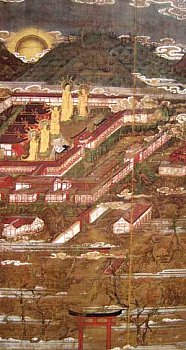
Kasuga Mandala 春日曼荼羅
No source or date given.
Courtesy this e-Site.
Four Shinto kami shrines
next to their Buddhist counterparts
are shown in the inner court,
symbolizing the syncretic nature
of the Kasuga tradition.
The fifth, I believe, represents the
Buddhist patron of the original
shrine at Mt. Mikasa.
|
|
Katsuma Mandala 羯磨曼荼羅. Deities represented by three-dimensional images. One of four basic artistic/stylistic mandala cateogories. See also Shuji Mandala (Sanskrit syllables), Sanmaya Mandala (symbolic objects), and Shishu Mandala (human form).
Kichijōten (Kisshōten) Mandala 吉祥天曼荼羅. A type of Besson Mandala devoted to the Celestial Gods Family, in this case to the deity known as Kichijōten (Kichijoten). Also read Kisshōten (Kisshoten). This goddess is depicted in the center of the mandala, flanked on the left and right by Bonten 梵天 and Taishakuten 帝釈天. A six-tusked white elephant is also typically shown.
Kōbō Daishi 弘法大師 (774 - 835 AD). Also spelled Kobo Daishi. Literally “Great Master Kōbō” or “Great Master Who Spread the Teachings.” It is the posthumous name for Kūkai, the founder of Japan's Shingon 真言 sect of Esoteric Buddhism (Jp. = Mikkyō 密教). The flowering of mandala artwork in Japan is generally credited to Kūkai (aka Kōbō Daishi) and Shingon traditions. See Shingon for details.
Kōdaigedatsu Dai Mandala 広大解脱大曼荼羅. A type of Toe Mandala showing various deities from numerous deity families; described in the Fukūkenjaku Jinpen Shingonkyō 不空羂索神変真言経 (Taishō No. 1092).
Kōfukuji Mandala 興福寺曼荼羅. Also Kofukuji Mandala. See Kasuga Mandala for details and photo.
Kojima Mandala 子島曼荼羅. A designated national treasure. Also read Koshima Mandara. Famous pair of the mandala of the two realms (Ryōkai Mandala), originally kept at Kojimadera Temple 子島寺 in Nara but now located at the Nara National Museum. Also known as Tobi Mandala 飛曼荼羅 or Hikō Mandara 飛行曼荼羅 (both meaning "flying mandara").
Kongōkai Mandala 金剛界曼荼羅. Also Kongokai Mandara. Rendered in English as the Diamond World Mandala or Adamantine World Mandala. Centered on Dainichi Buddha大日如来. It is one of the most popular mandala forms among Japan's Esoteric sects. Paired with the Taizōkai Mandala, it is known as the Ryōkai Mandala (or Mandala of the Two Realms/Worlds). Both are typically hung in the halls of Esoteric temples, one on the east side and the other on the west. The Kongōkai Mandala was first described in the Kongōchōkyō 金剛頂経 (Diamond Peak Sutra; Skt. = Sarvatathagatatattvasa mgraha). In Japan, it is also known as the Wisdom Mandala (Chi Mandara 智曼荼羅), the Mandala of Result (Ka Mandara 果曼荼羅), and the Great Mandala of the Adamantine Realm (Kongōkai Daimandara 金剛界大曼荼羅). It is commonly composed of 37 deities (see Kongōkai Sanjūshichison).
Kongōkai Hachijūisson Mandala 金剛界八十一尊曼荼羅. 81 Deities Mandala of the Adamantine Realm. This mandala corresponds to the central assembly (Jyōshin-e 成身会) of the Kue Mandala, but with variations, namely all the deities appear as Bodhisattva; brought from China to Japan by Ennin 円仁 (794-864); used primarily in the Taimitsu 台密 branch of the Tendai 天台 sect and less so by the Shingon 真言 sect.
Kongō Himitsu Mandala 金剛秘密曼荼羅. Also Kongo Himitsu Mandala. Lit. = Adamantine Secret Mandara. See Sanmaya Mandala.
Kongōkai Sanjūshichison 金剛界三十七尊. Also Kongokai Sanjushichison. 37 Deities Mandala of the Adamantine Realm. Centered around Dainichi Nyorai 大日如来 and composed of the Five Gochi Nyorai 五智如来, 16 Great Bodhisattvas (Jūroku Daibosatsu 十六大菩薩), Four Paramita Bodhisattva (Shiharamitsu Bosatsu 四波羅蜜菩薩), Eight Offering Bodhisattva (Hachikuyō Bosatsu 八供養菩薩), and Four Guardian Bodhisattva (Shishō Bosatsu 四摂菩薩). These 37 deities are classified into five families: (1) Nyorai-bu 如来部, Buddha Realm, Skt. = Tathagata-kula; (2) Kongōbu 金剛部, Adamantine Realm, Skt. = Vajra-kula; (3) Hōbu 宝部, Jewel Realm, Skt. = Ratna-kula; (4) Rengebu 蓮華部, Lotus Realm, Skt. = Padma-kula; and (5) Katsumabu 羯磨部, Action Realm, Skt. = Karma-kula. The Tathagata family is positioned in the center, with the other four placed in the four compass quarters, thus creating perfect symmetry both horizontally and vertically. This format has gained great popularity in Japan.
Kongōkai Sanjūshichison Mandala Zuzō 金剛界三十七尊曼荼羅図像. Mandala of the 37 Deites of the Diamond World. Brought to Japan by Saichō 最澄 (766-822); kept originally at Shōren'in Temple 青蓮院 in Kyoto, but now at the Metropolitan Museum of Art in New York; differs somewhat from orthodox Kongōkai layout.
Kongōyasha Mandala 金剛夜叉曼荼羅. Kongoyasha Mandala, also written 金剛薬叉明王. Corresponds to Kongōyasha Myō-ō 金剛夜叉明王 (Kongoyasha Myo-o, Skt. = Vajrayaksa), who is also considered one of the 16 Great Bodhisattvas (Jūroku Daibosatsu 十六大菩薩) of the Kongōkai Mandala and also one of the Five Great Myō-ō (Godai Myō-ō五大明王), the fierce gods who preside over the five directions (center and four compass points). Among Shingon sects, he represents the wrathful manifestation of Fukūjōju (Fukujoju) 不空成就, one of the Five Buddha of the Diamond Realm, he who commands the northern quarter. In the Tendai 天台 sect, his position is assumed by a different deity named Ususama Myō-ō 烏枢沙摩明王. His rite was carried out to to gain the love and respect of others and to subdue demons and enemies. However, Kongōyasha never gained a following in Japan, and extant artwork of this mandala remains rare.
Konpon Mandala 根本曼荼羅. Literally "Root Mandala." The name given to the first images of the two mandala (Ryokai Mandala) brought back from China to Japan by Priest Kūkai (774 - 835 AD). The Shingon mandala lineage based on these "root" mandala is known as the "Genzu" or "original image" mandala. See Genzu Mandala.
Koshima Mandala. See Kojima Mandala above.
Kōya Mandala. Also spelled Koya Mandala. Mt. Kōya is home to the Shingon sect, which was founded by Kūkai 空海 (774 - 835 AD) in the 9th century. The main monastery at Mt. Kōya is Kongōbuji Temple 金剛峯寺 (Wakayama Prefecture). The mummified body of its founder (known posthumously as Kōbō Daishi 弘法大師) still lies there. Today the Mt. Kōya complex remains one of Japan’s most popular pilgrimedge sites. Kūkai and the Japanesese Shingon sect are credited, more than any other religious tradition, with introducing and propagating the mandala artform in Japan. The Mt. Kōya complex of shrine-temples houses a voluminous collection of mandala from the 9th century onward. Many of these are included here, on this web page. They include numerous Besson Mandala and mandala in the “Sutra Rite” family. Mandala associated with this important monestary and complex sometimes show sixteen peaks depicted as eight inner and eight outer petals, said to represent the Taizōkai Mandala and Kongōkai Mandala respectively. Below we discuss two categories of Kōya paintings. These paintings and scrolls are not generally considered MANDALA, but their widespread use can be broadly classified as a type of mandala. See Kōya Shijyō Myōjin below.
|
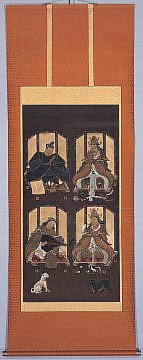
|
|
Daijyoji Temple 大乗寺
Modern Reproduction
Kōya Shijyō Myōjin
高野四所明神
Four Myōjin of Mt. Kōya
TOP
(L) Kariba Myōjin 狩場明神
(R) Niu Myōjin 丹生明神
BOTTOM
(L) Kehi Myōjin 気比明神
(R) Miyajima Myōjin 厳島明神
|
|
 Kōya Shijyō Myōjin 高野四所明神 Kōya Shijyō Myōjin 高野四所明神
Also written Koya Shijyo Myojin. Literally "Four Deities of Mt. Kōya." All four are commonly depicted in scrolls and paintings associated with the Shingon complex at Mt. Kōya (Wakayama Prefecture) and its main temple Kongōbuji 金剛峯寺.
Niu Myōjin and Kariba Myōjin are the two main guardians (Chinju 鎮守) of the Mt. Kōya monastery. The other two were added later to create a grouping of four known as the Kōya Shisho Gongen 高野四所権現 or Kōya Shisha Myōjin 高野四社明神. The four are venerated at Amano Jinja 天野神社 (aka Niutsuhime Jinja 丹生都比売神社).
- Niu Myōjin (female) 丹生明神; her Shintō counterpart is Niutsu-hime no Ookami 丹生都比売大神
- Niu’s son is Kariba Myōjin 狩場明神; also called Kōya Myōjin 高野明神; his Buddhist counterpart (honjibutsu 本地仏) is Yakushi 薬師 or Dainichi 大日; his Shinto counterpart is Takanomiko no Ookami 高野御子大神
- Kehi Myōjin 気比明神; deity from Fukui Prefecture added later in Kamakura era to create grouping of four; Shinto counterpart is Oogetsu-hime no Ookami 大食都比売大神.
- Miyajima Myōjin 厳島明神; deity from Hiroshima Prefecture added later in Kamakura era to create grouping of four; Shinto counterpart = Ichikishima-hime no Ookami 市杵島比売大神.
(Source of Above List = http://www.niutsuhime.or.jp)
|
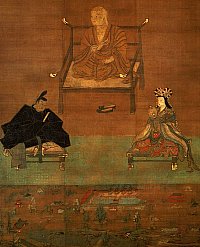
Question and Answer Ceremony
問答講本尊 (Mondōkō Honzon)
PAINTINGS OF THREE, , 14th Century
弘法大師・丹生・高野明神
Treasure of Kongōbuji Temple 金剛峯寺
Kūkai (at top center), along with the two tutelary deities of the Mt. Kōya monastery (Kariba Myōjin at left and his mother Niu Myōjin at right). The three serve as the main objects of worship in a scroll used for the Question-and-Answer Ceremony. Most pieces date to the Kamakura period. Most come from Kongōbuji Temple at Mt. Kōya.
|
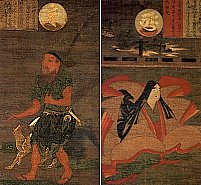
(L) Kariba Myōjin 狩場明神
(R) Niu Myōjin (female) 丹生明神
Treasure of Kongōbuji Temple 金剛峯寺
13th Century
Niu Myōjin is the mother mountain deity of Mt. Kōya, and gave permission to Kūkai to build the Kongōbuji Temple. Kariba, her son, is also known as Kōya Myōjin. He appeared to Kūkai as a hunter and then led Kūkai to the site where Kongōbuji Temple was built. In artwork, Niu Myōjin typically has the Siddham seed syllable (bonji) AAKU アーク written above her. Kariba typically has the seed syllable BAN written above him. Both are seed syllables for Dainichi Nyorai. AAKU symbolizes the Womb World and BAN the Daimond World. In artwork, Kariba is traditionally depicted with two dogs, for in the myths surrounding the creation of Kongōbuji Temple, Kariba appeared as a hunter with two dogs, one black, one white.
|
|
Kue Mandala 九会曼荼羅. Also spelled Ku-e. Main form of the Kongōkai Mandala used by Shingon sect. The Tendai sect, however, sometimes uses the Kongōkai Hachijūisson Mandala 金剛界八十一尊曼荼羅 instead. The central deity is typically Kongōsatta 金剛薩た. The disposition of the deities is identical to that of the Aizen Mandala, but in the latter the central deity is Aizen, not Kongōsatta.
 Kujaku Mandala 孔雀曼荼羅. Literally “Mandala of the Peacock King.” Statues of this deity, known as Kujaku Myō-ō 孔雀明王, are rare in Japan. A Kamakura-period Kujaku Mandara 孔雀曼荼羅 is owned by Matsuodera 松尾寺 in Osaka. <Says JAANUS> “A female deity of Indian orgin (Skt. Mahamayuri). In Japan, Kujaku means peacock, and because the peacock eats poisonous plants and snakes joyfully, finding in them the nectar which produces its beauty, Kujaku Myō-ō was revered from ancient times for transmuting the "poisons" of greed and anger and for eliminating karmic hindrances. The power of the darani 陀羅尼 (mystic formula recited for protection) of Kujaku was extolled in texts such as the Kujakuō Jukyō 孔雀王呪経, translated into Chinese variously from the 4th to 6th centuries. Popularly, the darani was also said to protect one from illness, especially snake bites. Eventually it was also applied more widely, to such matters as making rain start and stop. Although there are no extant images of Kujaku Myō-ō in India, there are extant images of her in both China, Tibet, and Japan. In Japan she was revered from the Nara period (8c) and is mentioned in the Nihon Ryōiki 日本霊異記, compiled in the early 9th century. Kujaku appears in the Taizōkai Mandara as a two-armed figure, without her peacock. From the mid-Heian period onward, Kujaku was propitiated in a ritual called Kujaku Myō-ō-kyō-hō 孔雀明王経法 for averting disasters, particularly in prayers for rain, against illness in the imperial family, and for safe childbirth of the empress. This is a secret Shingon 真言 ritual that was performed especially at Ninnaji Temple 仁和寺 in Kyoto." <end JAANUS quote> Kujaku Mandala 孔雀曼荼羅. Literally “Mandala of the Peacock King.” Statues of this deity, known as Kujaku Myō-ō 孔雀明王, are rare in Japan. A Kamakura-period Kujaku Mandara 孔雀曼荼羅 is owned by Matsuodera 松尾寺 in Osaka. <Says JAANUS> “A female deity of Indian orgin (Skt. Mahamayuri). In Japan, Kujaku means peacock, and because the peacock eats poisonous plants and snakes joyfully, finding in them the nectar which produces its beauty, Kujaku Myō-ō was revered from ancient times for transmuting the "poisons" of greed and anger and for eliminating karmic hindrances. The power of the darani 陀羅尼 (mystic formula recited for protection) of Kujaku was extolled in texts such as the Kujakuō Jukyō 孔雀王呪経, translated into Chinese variously from the 4th to 6th centuries. Popularly, the darani was also said to protect one from illness, especially snake bites. Eventually it was also applied more widely, to such matters as making rain start and stop. Although there are no extant images of Kujaku Myō-ō in India, there are extant images of her in both China, Tibet, and Japan. In Japan she was revered from the Nara period (8c) and is mentioned in the Nihon Ryōiki 日本霊異記, compiled in the early 9th century. Kujaku appears in the Taizōkai Mandara as a two-armed figure, without her peacock. From the mid-Heian period onward, Kujaku was propitiated in a ritual called Kujaku Myō-ō-kyō-hō 孔雀明王経法 for averting disasters, particularly in prayers for rain, against illness in the imperial family, and for safe childbirth of the empress. This is a secret Shingon 真言 ritual that was performed especially at Ninnaji Temple 仁和寺 in Kyoto." <end JAANUS quote>
Kūkai 空海 (774 - 835 AD). Also spelled Kukai, Kuukai. Founder of Japan's Shingon 真言 sect of Esoteric Buddhism (Jp. = Mikkyō 密教) His posthumous name is Kōbō Daishi 弘法大師 (Kobo Daishi). The flowering of mandala artwork in Japan is credited primarily to Kūkai and the Shingon sect rather than to Saichō 最澄 (767 - 822 AD) and the Tendai sect. For more details on Kūkai, see Shingon below or visit the Esoteric Buddhism page.
Kumano Mandala 熊野曼荼羅. Religious paintings of Kumano Sanzan 熊野三山, or the three shrines of Kumano, known as Hongū 本宮 (Kumano Nimasu Jinja 熊野座神社), Shingū 新宮 (Kumano Hayatama Jinja 熊野速玉神社 ), and Nachi 那智 (Kumano Fusumi Jinja 熊野夫須美神社). The three are located at the southern tip of Wakayama prefecture. See mandala photos below this entry. In terms of artistic output and influence, Kumano is one of the three most important syncretic Shintō-Buddhist sites in Japan, along with the Kasuga 春日 complex in Nara (see Kasuga Mandala) and the Sannō 山王 shrine-temple multiplex near Kyoto (see Hie Sannō Mandala). According to the text known as Chōshūki 長秋記, by 1134 the Buddhist counterparts (Honjibutsu 本地仏) of the Shinto kami 神 at Kumano were Amida Buddha 阿弥陀 for Hongū (Ketsu no Miko Kami 家都御子神), Yakushi Buddha 薬師 for Shingū (Hayatama no Kami 速玉神), and Senju Kannon 千手観音 for Nachi (Fusumi 夫須美 or Musubi no Kami 結びの神). The first written record of Kumano paintings appeared during the reign of Emperor Gotoba 後鳥羽 (1180 - 1239). It circulated around 1214, and referred to landscape paintings of the Kumano shrines and its deities. Since then, extant paintings dating from the Kamakura period into the Edo era have come in two general flavors. The first type is called the Miya Mandala, a general category for art that depicts shrine sanctuaries and landscapes. The second type is the Songyō Mandala, an artform that provides illustrations of the deities. But by late Heian period, the mandala paintings of Kumano took on a proselytizing feel, and pilgrimage organisers in later periods created striking paintings of Kumano to drum up visitors. Such pilgrimage paintings are generally called Sankei Mandala. They were used in general to popularize famous holy sites. One type of explanatory painting was known as the Kanshin Jikkai E-zu観 心十界絵図 -- also called the Kumano Kanshin Mandala 熊野観心曼荼羅. It described the ten Buddhist realms into which people are reborn based on their behavior while alive. It showed people walking from the east as babies, but becoming old as they approached the west. Numerous syncretic deities are associated with Kumano as well, in particular the Kumano Sansho Gongen 熊野三所権現 (Three Avatars of Kumano) and another grouping of twelve called the Kumano Junisha Gongen 熊野十二社権現 (12 Avatars of Kumano). All appear regularly in paintings of Kumano. As early as the 8th century, Kumano was considered the paradise of Amida, Kannon, and Fudarakusen 補陀落山. By the Heian period, the pilgrimage to Kumano was important to all classes of people. In the Kamakura and Muromachi periods, Kumano was the most popular pilgrimage site in Japan. Kumano was also associated early on with Yoshino 吉野, a nearby mountainous area closely linked to the Shugendō sect, one of Japan’s most important early syncretic sects of ascetic mountain practice and worship. < See Yoshino Mandala; also see Kumano Entry at JAANUS >
|
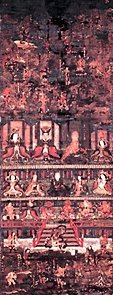
Kumano Suijaku Mandala
熊野垂迹神曼荼羅図
Late Kamakura Period
Color on Silk, H 105.0 cm, W 40.8 cm
Courtesy this J-site
|
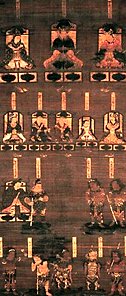
Kumano Suijaku Mandala
熊野垂迹神曼荼羅図
Early Muromachi Period 室町時代
Color on Silk, H 87.5 cm, W 37.9 cm
Courtesy this J-site
|
|
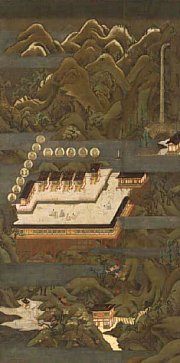
Kumano Mandara, Nachi Shrine
Late 14th or Early 15th century
Hanging scroll; 220.3 x 76.3 cm
Ink, color, and gold on silk.
Buddhist deities encircled in two intersecting lines, with shrine in center framed by Shinto kami of Kumano. Courtesy Freer Gallery of Art
|
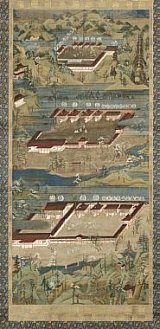
Kumano Mandala
Three Sacred Shrines of Kumano
H 134 cm x W 62 cm
Late Kamakura Period
Courtesy
Cleveland Museum of Art
|
|
|
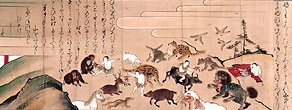
|
Kumano Gongen Engi Emaki
熊野権現縁起絵巻
Edo Era 江戸時代 (1637)
One of three extant narrative scrolls.
Courtesy this J-site
|
|
|
|
Lotus Mandala. See Hokke (Hoke) Mandala.
|
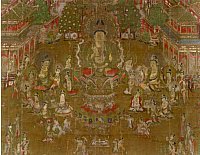
|
|
Tosotsuten Mandala
兜率天曼荼羅
Began appearing in Kamakura period,
and depicted Miroku in Tusita Heaven.
Shiga Prefecture, Important Prefectural Property, Color on Silk; no date given at below site.
Courtesy this J-site
|
|
 Miroku Mandala 弥勒曼荼羅 or Miroku Bosatsu Mandara 弥勒菩薩曼荼羅. Classified as a Besson Mandala, one featuring a single deity from the Bodhisattva Family, in this case Miroku 弥勒, the Future Buddha. Extant examples of this mandala from the Kamakura period are preserved at Daigoji Temple 醍醐寺 (Kyoto) and at Reiunji Temple霊雲寺 (Tokyo). In Esoteric Buddhism, Miroku appears in the Eight-Petal Court of the Taizōkai Mandala, and in the Kongōkai Mandala as one of the 16 Deities of the Auspicious Aeon (Gengō Jūrokuson 賢劫十六尊). A 30-armed form of Miroku is also mentioned in iconographic texts, but no statuary or mandala of this type exists. Miroku also appears in the Tosotsuten Mandala 兜率天曼荼羅 depecting Miroku’s Tusita Heaven (one is preserved at Enmeiji 延命寺 in Osaka), as well as in paintings known as the Miroku Raigō-zu 弥勒来迎図 (one is preserved at Shōmyōji Temple 称名寺 in Kanagawa prefecture). The latter show Miroku’s descent to earth to bring devotees back to Miroku’s Pure Land. Miroku is one of the Thirteen Buddha (Jūsanbutsu 十三仏). In this role, Miroku presides over the memorial service on the 42nd day after one’s death. Miroku Mandala 弥勒曼荼羅 or Miroku Bosatsu Mandara 弥勒菩薩曼荼羅. Classified as a Besson Mandala, one featuring a single deity from the Bodhisattva Family, in this case Miroku 弥勒, the Future Buddha. Extant examples of this mandala from the Kamakura period are preserved at Daigoji Temple 醍醐寺 (Kyoto) and at Reiunji Temple霊雲寺 (Tokyo). In Esoteric Buddhism, Miroku appears in the Eight-Petal Court of the Taizōkai Mandala, and in the Kongōkai Mandala as one of the 16 Deities of the Auspicious Aeon (Gengō Jūrokuson 賢劫十六尊). A 30-armed form of Miroku is also mentioned in iconographic texts, but no statuary or mandala of this type exists. Miroku also appears in the Tosotsuten Mandala 兜率天曼荼羅 depecting Miroku’s Tusita Heaven (one is preserved at Enmeiji 延命寺 in Osaka), as well as in paintings known as the Miroku Raigō-zu 弥勒来迎図 (one is preserved at Shōmyōji Temple 称名寺 in Kanagawa prefecture). The latter show Miroku’s descent to earth to bring devotees back to Miroku’s Pure Land. Miroku is one of the Thirteen Buddha (Jūsanbutsu 十三仏). In this role, Miroku presides over the memorial service on the 42nd day after one’s death.
Miya Mandala 宮曼荼羅. Literally Shrine Mandala. A painting that depicts a shrine, its landscape, the arrangement of its salient buildings, and other noteworthy features. Similar in many ways to a tourist map. See Ise Mandala, Kasuga Mandala, Kumano Mandala, and Hakusan Mandala. Miya Mandala do not depict the Shintō (Shinto) kami in human form. One of four major mandala categories in Japan. See Quick Quide.
|
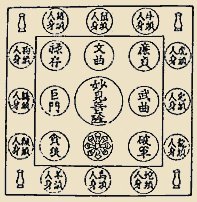
Myōken Mandala 妙見曼荼羅
Deity Positioning Chart
Courtesy this J-site
|
|
 Myōken Mandala 妙見曼荼羅. Classified as a Besson Mandala, one featuring a single deity from the Celestial Gods Family, in this case Myōken (Myoken) 妙見. Also considered a Hoshi (Star) Mandala. Myōken (Skt. = Sudrsti) is also known in Japan as Sonshō-ō 尊星王, Myōken Son 妙見尊, Hokushin北辰, Hokushin Bosatsu 北辰菩薩, and Hokuto Myōken Bosatsu 北斗妙見菩薩. Belief in Myōken reportedly began in Japan in the 9th century after his/her attributes were described in the Nihon Ryōiki 日本霊異記 (alternate readings include Nihon Rei-iki or Nippon Reiiki). The text's full title is Nihonkoku Genpō Zen'aku Ryōiki 日本国現報善悪霊異記, which is commonly translated as "Miraculous Stories of Karmic Retribution of Good and Evil in Japan.” S/he was originally considered a deification of the Polestar (Hokushin 北辰), but because of confusion between the Polestar and the Big Dipper, s/he also became associated with the Big Dipper (Hokuto 北斗). See Hokuto Mandala. S/he is popularly regarded as a Bodhisattva (hence her name Myōken Bosatsu 妙見菩薩), but this is wrong. She should more properly be classied as one of the Ten 天 (Skt. = Deva), and categorized into the Celestial Gods Family. Among followers of the Jimon 寺門 branch of the Tendai 天台 sect, she is equated with Kichijōten 吉祥天, and is invoked for apotropaic functions and for healing eye diseases. She was partially adopted in the Shintō pantheon, where she is known as Myōkenjin (Myokenjin) 妙見神 and shown with a halo depicting the seven stars of the Big Dipper and holding a sword. The Nichiren 日蓮 sect also includes her as one of its deities, and even today she remains a relatively popular divinity. Artwork of Myōken exhibits much diversity. The term Myōken 妙見 literally means "heavenly eyes" or "heavenly sight," or "one who sees all." His/her attributes are not firmly set, but in Japan the deity often appears with two arms or four arms, is shown seated on a cloud or standing atop a dragon or turtle. For numerous photos, please see the Myōken Page. Myōken Mandala 妙見曼荼羅. Classified as a Besson Mandala, one featuring a single deity from the Celestial Gods Family, in this case Myōken (Myoken) 妙見. Also considered a Hoshi (Star) Mandala. Myōken (Skt. = Sudrsti) is also known in Japan as Sonshō-ō 尊星王, Myōken Son 妙見尊, Hokushin北辰, Hokushin Bosatsu 北辰菩薩, and Hokuto Myōken Bosatsu 北斗妙見菩薩. Belief in Myōken reportedly began in Japan in the 9th century after his/her attributes were described in the Nihon Ryōiki 日本霊異記 (alternate readings include Nihon Rei-iki or Nippon Reiiki). The text's full title is Nihonkoku Genpō Zen'aku Ryōiki 日本国現報善悪霊異記, which is commonly translated as "Miraculous Stories of Karmic Retribution of Good and Evil in Japan.” S/he was originally considered a deification of the Polestar (Hokushin 北辰), but because of confusion between the Polestar and the Big Dipper, s/he also became associated with the Big Dipper (Hokuto 北斗). See Hokuto Mandala. S/he is popularly regarded as a Bodhisattva (hence her name Myōken Bosatsu 妙見菩薩), but this is wrong. She should more properly be classied as one of the Ten 天 (Skt. = Deva), and categorized into the Celestial Gods Family. Among followers of the Jimon 寺門 branch of the Tendai 天台 sect, she is equated with Kichijōten 吉祥天, and is invoked for apotropaic functions and for healing eye diseases. She was partially adopted in the Shintō pantheon, where she is known as Myōkenjin (Myokenjin) 妙見神 and shown with a halo depicting the seven stars of the Big Dipper and holding a sword. The Nichiren 日蓮 sect also includes her as one of its deities, and even today she remains a relatively popular divinity. Artwork of Myōken exhibits much diversity. The term Myōken 妙見 literally means "heavenly eyes" or "heavenly sight," or "one who sees all." His/her attributes are not firmly set, but in Japan the deity often appears with two arms or four arms, is shown seated on a cloud or standing atop a dragon or turtle. For numerous photos, please see the Myōken Page.
Nichiren 日蓮 (1222-82). See Hokke Mandala above.
|
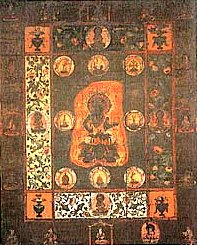
|
|
Ninnōgyō Mandala 仁王経曼荼羅
Jinjōji Temple 神上寺
Yamaguchi Pref.
Used in rites of pacification.
Important Cultural Property.
Photo courtesy this J-Site
|
|
 Ninnōgyō Mandala 仁王経曼荼羅. Also Ninnogyo Mandala. Classified as a Besson Mandala, one featuring a single deity from the Myō-ō Family, in this case Fudō Myō-ō (Fudo Myo-o) 不動明王, who is the wrathful emanation of Dainichi Buddha 大日如来. Also considered a mandala of the Sutra-Rite Family. The mandala is based on a translation of the Ninnōgyō Sutra 仁王経 and a related ritual manual, with Fudō Myō-ō shown in the center surrounded by symbolic objects representing the Four Bodhisattva (Kongōsatta 金剛薩た, Kongōhō 金剛宝, Kongōri 金剛利 and Kongōge 金剛牙), and the Four Inner Offering Bodhisattva (Joy, Garland, Song and Dance). The Four Myō-ō 明王 (Gōsanze 降三世明王, Gundari 軍荼利明王, Daiitoku 大威徳明王 and Kongōyasha 金剛夜叉明王) appear in the second enclosure (east, south, west and north respectively), while the Four Guardian Bodhisattva (Shishō Bosatsu 四摂菩薩) and Guardians of the Four Directions (aka Taishakuten 帝釈天, Katen 火天, Fūten 風天 and Suiten 水天) are depicted in the outer enclosure. The Myō-ō iconography differs greatly from orthodox depictions. Fudō, for example, holds a wheel instead of a noose in his left hand. One version of this mandala is used in rites of pacification 息災 (sokusai), and the upper quarter of this version represents north. Another version is used in rites for increasing prosperity 増益 (zōyaku), with the upper quarter representing east. <See JAANUS Entry for more details> Ninnōgyō Mandala 仁王経曼荼羅. Also Ninnogyo Mandala. Classified as a Besson Mandala, one featuring a single deity from the Myō-ō Family, in this case Fudō Myō-ō (Fudo Myo-o) 不動明王, who is the wrathful emanation of Dainichi Buddha 大日如来. Also considered a mandala of the Sutra-Rite Family. The mandala is based on a translation of the Ninnōgyō Sutra 仁王経 and a related ritual manual, with Fudō Myō-ō shown in the center surrounded by symbolic objects representing the Four Bodhisattva (Kongōsatta 金剛薩た, Kongōhō 金剛宝, Kongōri 金剛利 and Kongōge 金剛牙), and the Four Inner Offering Bodhisattva (Joy, Garland, Song and Dance). The Four Myō-ō 明王 (Gōsanze 降三世明王, Gundari 軍荼利明王, Daiitoku 大威徳明王 and Kongōyasha 金剛夜叉明王) appear in the second enclosure (east, south, west and north respectively), while the Four Guardian Bodhisattva (Shishō Bosatsu 四摂菩薩) and Guardians of the Four Directions (aka Taishakuten 帝釈天, Katen 火天, Fūten 風天 and Suiten 水天) are depicted in the outer enclosure. The Myō-ō iconography differs greatly from orthodox depictions. Fudō, for example, holds a wheel instead of a noose in his left hand. One version of this mandala is used in rites of pacification 息災 (sokusai), and the upper quarter of this version represents north. Another version is used in rites for increasing prosperity 増益 (zōyaku), with the upper quarter representing east. <See JAANUS Entry for more details>
Nyoirin Mandala 如意輪曼荼羅. Classified as a Besson Mandala, one featuring a single deity from the Kannon Family, in this case Nyoirin Kannon 如意輪観音, the omnipotent form of Kannon Bodhisattva. This mandala comes in various manifestations. Often the diety is shown with six arms and holding a wish-granting jewel. Some show Nyoirin on a rock (which represents Kannon's paradise) rising from the sea. Despite differing opinions about Nyoirin’s meaning, it is generally believed s/he offers people what they want in this world or in the monastic life. The jewel s/he holds represents wisdom, the Buddha-nature, aspiration to enlightenment, and wealth. The wheel s/he holds represents the Dharma (the Buddhist teachings). The wheel’s eight spokes represent the eightfold path to enlightenment taught by Shaka Nyorai 釈迦如来 (the Historical Buddha). Nyoirin's six arms represent the Six Realms (Rokudō 六道) of karma and rebirth. Nyoirin Kannon sometimes appears in a golden color in the Rengebu-in section 蓮華部院 (Lotus Court section; aka Kannon-in section 観音院) of the Taizokai Mandala. Another mandala form is the Shichishō Nyoirin Mandala 七星如意輪曼荼羅, a type of Hoshi (Star) Mandala. It can be translated literally as the Seven-Star Nyoirin Mandala (other spellings: Shichisho, Shichishou).
Rishukyō Mandala 理趣経曼荼羅. Also Rishukyo Mandala. A painting that symbolizes the doctrines of the Rishukyō 理趣経 (Skt. = Prajnaparamitanaya Sutra), commonly known as the Sutra of the Principle of the Perfection of Wisdom. The 17th-section sutra (Jūshichidan 十七段) is represented in 17 (seventeen) different mandara, which are collectively known as the Jūshichidan Mandara (Jushichidan, Juushichidan) 十七段曼荼羅. There is also an 18 (eighteen) section mandara called the Rishukyō (Rishukyo) Jūhachi-e Mandara 理趣経十八会曼荼羅 wherein a Setsu-e Mandala 説会曼荼羅 (lit. = explanatory mandala) depicts the scene when the sutra was expounded. The latter was introduced from China to Japan by Ennin 円仁 (794-864) and Shūei 宗叡 (Shuei; 809-884). The 2nd mandala of this 18-mandara set is the most important. It is called the Tairaku Mandala 大楽曼荼羅, or Mandala of Great Bliss. It was not only modified to conform with the Kongōkai Mandala, but also incorporated into the Kue Mandala as the Rishu-e 理趣会. The ninth mandara is the Nyūdairin (Nyudairin, Nyuudairin) Mandala 入大輪曼荼羅, or Mandala for Entering the Great Circle. It was used separately and called the Dairin Myō-ō Mandala 大輪明曼荼羅王, while the eighteenth Jinpi Mandala 深秘曼荼羅 (Mandala of Profound Secrets) was called the Gohimitsu Mandala 五秘密曼荼羅 (Mandala of the Five Secrets). There are few extant examples of these various mandala, and they were never widely used. <see JAANUS for larger entry the on Rishukyo Mandala>
 Rokuji Mandala 六字経曼荼羅. Also called the Rokujikyō (Rokujikyo Mandala), literally Six Letter Mandala. Centered on Shaka Nyorai 釈迦 (the Historical Buddha) holding a gold wheel (hōrin 法輪). See Hokuto Mandala for more about this form of Shaka. The central deity is surrounded by Six Kannon (Roku Kannon 六観音), and the group of seven appear within a moon disc. At the top of the mandala are two flying celestials (hiten 飛天); at the bottom are images of Fudō Myō-ō 不動明王 and Daiitoku Myō-ō 大威徳明王, and positioned between them are six figures venerating a smaller moon disc. Says JAANUS: “Images of the Six Kannon began to be made as offerings for the welfare of the dead and for personal salvation in the first half of the 10th century. The Six Kannon appear in the most common form of the Rokujikyō Mandala, which from the Heian period was the focus of the Rokujikyōhō 六字経法, a Shingon ritual used particularly for sickness and childbirth. The six forms of Kannon often appear along with their corresonding Sanskrit bonjimon 梵字文. <end JAANUS quote> Rokuji Mandala 六字経曼荼羅. Also called the Rokujikyō (Rokujikyo Mandala), literally Six Letter Mandala. Centered on Shaka Nyorai 釈迦 (the Historical Buddha) holding a gold wheel (hōrin 法輪). See Hokuto Mandala for more about this form of Shaka. The central deity is surrounded by Six Kannon (Roku Kannon 六観音), and the group of seven appear within a moon disc. At the top of the mandala are two flying celestials (hiten 飛天); at the bottom are images of Fudō Myō-ō 不動明王 and Daiitoku Myō-ō 大威徳明王, and positioned between them are six figures venerating a smaller moon disc. Says JAANUS: “Images of the Six Kannon began to be made as offerings for the welfare of the dead and for personal salvation in the first half of the 10th century. The Six Kannon appear in the most common form of the Rokujikyō Mandala, which from the Heian period was the focus of the Rokujikyōhō 六字経法, a Shingon ritual used particularly for sickness and childbirth. The six forms of Kannon often appear along with their corresonding Sanskrit bonjimon 梵字文. <end JAANUS quote>
Ryōbu (Ryobu) Mandala 両部曼荼羅. Mandala of the Two Realms (Worlds). See Ryōkai Mandala. The term Ryōbu is generally attributed to the Shingon Sect, and refers to schemes whereby Shinto deities are given Buddhist counterparts. The Shingon doctrines associate the Inner Shrine of Ise (see Ise Mandala) with the Womb Realm (Taizōkai), and the Outer Shrine with the Vajra Realm (Kongōkai). The central deity in both realms is Dainichi Buddha 大日如来.
Ryōkai Mandala 両界曼荼羅 (also written Ryokai or Ryogai). Mandala of the Two Realms, or Mandala of the Two Worlds. Composed of the Taizōkai (Taizokai) and Kongōkai (Kongokai) mandalas. The two represent a unified pair, and are customarily hung facing each other in temple halls, the Taizōkai on the east side and Kongōkai on the west. Orthodox versions were introduced from China to Japan by Kūkai 空海 (Kukai, Kuukai; 774-835), and numerous copies and variations made from them. The pair depicts the myriad deities in the Buddhist pantheon. This two-mandala format underpins the teaching of Esoteric Buddhism in Japan. Says JAANUS: “The term Ryōkai Mandara is thought to have been first used by Godaiin Annen 五大院安然 (841-889~898) of the Tendai 天台 sect. Because of its associations with the Tendai Sect, there are even today many Shingon 真言scholars who instead prefer the term Ryōbu Mandala, or "Mandala of the Two Divisions." However, the term " Ryōkai Mandara" is the term used by modern art historians, and also used by Japanese authorities to designate national treasures and important cultural properties. There are minor differences in the disposition of the deities.” <end JAANUS quote> For more details, see Mandala Quick Guide.
|
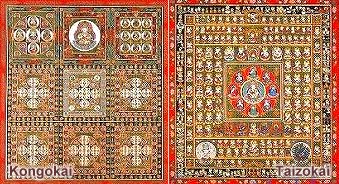
RYOKAI MANDALA 両界曼荼羅
Modern Reproductions of the Kongokai and Taizokai
|
|
Saichō 最澄 (767 - 822 AD). Also spelled Saicho. Founder of Japan's Tendai 天台 sect of Esoteric Buddhism (Jp. = Mikkyō 密教). His posthumous name is Dengyō Daishi 伝教大師 (Great Master Who Transmitted the Teachings). Despite his many contributions, the flowering of mandala artwork in Japan is generally credited to Kūkai (aka Kōbō Daishi) and Shingon traditions. See Esoteric Buddhism for a few more details on Saichō.
Sangatsu-kyō Mandala 三月経曼荼羅. Also Sangatsukyo Mandala. Devoted to Shaka Nyorai, the Historical Buddha, and therefore classified as a Besson Mandala. Depicts the Shaka Triad, with Shaka seated in the center and surrounded by Monju Bodhisattva (often atop lion) and Fugen Bodhisattva (often atop white elephant). Monju symbolizes wisdom, while Fugen symbolizes meditation and practice. The 16 Protectors of Shaka (Shaka Jūroku Zenshin 釈迦十六善神) often appear as well.
|
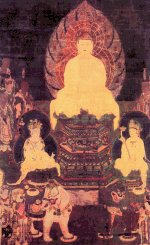
|
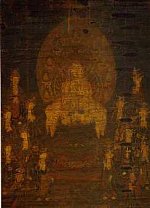
|
|
Sangatsu-kyo Mandala
三月経曼荼羅図
Hanging scroll, 13th-14th century
Color on silk, H 237.6 cm W 134.2 cm
Shana-in Temple 舎那院, Shiga Pref.
Courtesy this E-site
|
Sangatsu-kyo Mandala
三月経曼荼羅
Kamakura Era, 13th century
Mantokuji Temple 萬徳寺
Inazawa City, Nagano
Courtesy this J-site
|
|
Sanjūshichisonyō (Sanjushichisonyo) 三十七尊様. Depicts the deities of the Kongōkai Mandala. It was first introduced from China to Japan in 805 by Saichō 最澄 (766-822), the founder of Japan’s Tendai 天台 sect, who also introduced the Daibutchō Tsūyō Mandala, a variety of Besson Mandala. Despite Saichō's many contributions to Buddhist faith and art in Japan, the flowering of Japanese mandala artwork is credited primarily to Kūkai and the Shingon sect.
Sankei Mandala 参詣曼荼羅. Pilgrimage paintings that depict a specific shrine (or temple), its environs, landscapes, and pilgrims attending to their religious duties. It is a broad category, and includes such mandala as the Ise Mandala, Kasuga Mandala, Fuji Mandala, Kumano Mandala, and others. Unlike Miya Mandala, which are often static representations of a shrine layout, Sankei Mandara tend to present a dynamic aspect, one that describes the activities undertaken by shrine (or temple) visitors, and thus sankei paintings are commonly filled with figures of people moving through the sacred space. One of four major mandala categories in Japan. See Quick Quide.
Sanmaya (Samaya) Mandala 三昧耶曼荼羅. One of four basic artistic/stylistic mandala cateogories, one in which the deities are depicted by means of symbolic objects (三昧耶形, Sanmayagyō, Sanmayagyo). See also Katsuma Mandala (three-dimensional images), Shishu Mandala (human form), and Shuji Mandala (Sanskrit syllables). Symbolic objects include the Lotus (Hasu 蓮) and the Vajra (金剛杵, Kongōshō, Kongousho). A close cousin of the Sanmaya Mandala is the Dai Mandala 大曼荼羅 (Great Mandala). The latter shows the deities in their physical form (like the Shishu Mandala). It represents the “mystery of the body” (Shinmitsu 身密), whereas the Sanmaya Mandara represents the “mystery of mind” (Imitsu 意密). A typical Sanmaya Mandara is the Himitsu Mandala 秘密曼荼羅 (Secret Mandara), as described in the Dainichikyō (Dainichikyo) Sutra 大日経. Another is the Kongō (Kongo) Himitsu Mandala 金剛秘密曼荼羅 (Adamantine Secret Mandara) as described in the first chapter of the Kongōchōkyō (Kongochokyo) Sutra 金剛頂経 (Diamond Peak Sutra). Finally, there is the Daihitaizou Sanmaya Mandala 大悲胎蔵三昧耶曼荼羅 (no longer extant), which was brought back to Japan by Ennin 円仁 (794-864). It was a sanmaya-type line drawing of the Taizōkai Mandala, one closely related to the Taizō Zuzō. A copy of it (dated to 1019) is preserved at Daigoji Temple醍醐寺 in Kyoto, and it is considered Japan’s oldest extant copy of such iconographical line drawings. Finally, the Sanmaya Mandala also serves as a type of Shiki Mandala for Esoteric initiation rights. A typical example is preserved at Tōji (Toji) Temple 東寺in Kyoto and dated to the 16th century. <see JAANUS for more details>
Seikai Mandala 清海曼荼羅 (also read Shoukai mandara). <Below text courtesy JAANUS> One of Three Jodo Mandalas Jōdo Sanmandara 浄土三曼荼羅. A type of Amida Joudo Hansou 阿弥陀浄土変相, depicting a vision of the Pure Land granted by the Kannon 観音 of Kiyomizudera 清水寺 appearing as an old man, to the monk Seikai 清海 (also read Shokai, d.1017) in 996. Seikai, who came from Hitachi 常陸 (present-day Ibaraki prefecture), entered the priesthood at Koufukuji 興福寺, later moving to Choushouji 超昇寺, where he died whereby this mandala is sometimes called Choushouji mandara. The Seikai mandara is based on the KANMURYOUJUKYOU 観無量寿経 and may be considered a 'transformation scene of the Pure Land', Kangyou Hensou 観経変相, like the more well-known Taima Mandala 当麻曼荼羅. Although the original painting has been lost, several faithful copies survive. The Seikai mandara (dated to 1726) in Shoukouji 聖光寺, Kyoto, suggests the original was painted in gold and silver (kingindei 金銀泥) on indigo-dyed silk. Amida 阿弥陀 is in the center of the field flanked by his attendant bodhisattvas 菩薩, seated on a lotus throne in front of his two-storied palace surrounded by pavilions linked by bridges and a lotus pond in the foreground. The outer surrounding court of this painting has sixteen lotus thrones painted alternately in gold and silver that represent the Sixteen Contemplations (Jūrokkan, Jurokkan, 十六観) from the KANMURYOYJUKYOU. Other later copies are in the collections of Joukakuji 成覚寺, Miyagi prefecture and Kushira Joudoji 櫛羅浄土寺, Nara. <end JAANUS quote>
Shaji Mandala 社寺曼荼羅. See Kasuga Mandala. Includes images of both Kasuga Shrine and Kōfukuji Temple.
Shaka Mandala 釈迦曼荼羅. A mandala devoted to Shaka Nyorai 釈迦如来, the Historical Buddha, and therefore classified as a Besson Mandala. Other mandala centered on Shaka include the Bodaijō Manadala 菩提場曼荼羅, Hokke Mandala 法華曼荼羅, Hōrōkaku Mandala 宝楼閣曼荼羅, Sangatsu-kyō Mandala 三月経曼荼羅, and Shōugyō Mandala 請雨経曼荼羅. Shaka also appears in the center of the Shaka-in 釈迦院 section of the Taizōkai Mandala (with hands forming the tenbōrin-in "teaching" mudra). In the Kongōkai Mandala, Shaka appears in the form of Tenku Raion 天鼓雷音 (Skt. Divyadundubhimeghanir ghosa) in the Henchi-in section 遍知院 and as Fukūjōju 不空成就 among the Five Wisdom Tathagata (Gochi Nyorai 五智如来).
Shichishō Nyoirin Mandala, Shichisho Nyoirin Mandala, 七星如意輪曼荼羅. Seven-Star Nyoirin Mandala. Classified as a Hoshi Mandala. Centered on Nyoirin Kannon如意輪観音. See Nyoirin Mandala.
Shika Mandalaa 鹿曼荼羅 (literally Deer Mandala). See Kasuga Mandala.
Shiki Mandala 敷曼荼羅. Mandala for Laying Out. A scroll-like painting that can be spread out like a carpet. It is used during Esoteric initiation rites (Kanjō, Kanjo, Kanjou 潅頂; Skt. = Abhiseka), during which it is spread out on top of an altar. Originally, in India, where the initiation tradition is no longer practiced, the mandala was drawn with powdered pigment or colored sand, and then destroyed after only one use. The Shiki Mandara was probably devised in China as a substitute for these earlier forms. In Japan’s initiation rites, the initiand casts a flower that falls on one of the many deities shown on the mandala – that deity thereafter becomes his/her tutelary deity. For obvious reasons, few Shiki mandala are extant. The oldest known version is one preserved at Tōji (Toji) Temple 東寺 in Kyoto (dated 1112). Deities in this mandala are depicted facing the center (as are counterparts in Tibet and Nepal). There are also many examples of Shiki Mandara that assume the form of a Shuji Mandala (which depict the deities with Sanskrit syllables) or Sanmaya Mandala (which depict the deities with symbolic objects). A 16th-century example of the latter is preserved at Tōji Temple 東寺 in Kyoto. Some scholars suggest that Shuji and Sanmaya forms were used widely in Japan because it is more difficult to distinguish the deities in the human forms they assume on the Shiki Mandala.
Shingon 真言 Sect. Scholar-monk Kūkai 空海 (774 - 835 AD) founded Japan's Shingon 真言 sect. Like the Tendai 天台 sect founded by Kūkai's contemporary Saichō 最澄 (767 - 822), the Shingon school of Esoteric Buddhism (Jp. = Mikkyō 密教) originated in China. Kūkai traveled there on the same fleet of ships that carried Saichō, but the two did not meet apparently. Kūkai returned to Japan in 806 with numerous text, relics, and mandala artwork to spread the Shingon teachings. Indeed, the flowering of mandala artwork in Japan is credited primarily to Kūkai and his Shingon sect rather than to Saichō and the Tendai sect. The Japanese Shingon sect, in contrast to the multi-school Tendai sect, was predominantly Esoteric. Its doctrines were mystical and occult, and required a high level of austerity. Elaborate and secret rituals (utilizing mantras, mudras, and mandalas) were developed to help practitioners achieve enlightenment. Despite its complex practices, Shingon exerted a profound impact on religious art and the faith of the court and monastic orders. Kūkai is credited with introducing Japan to the so-called Konpon Mandala 根本曼荼羅, literally the "root mandala." This is the name given to the first images of the two mandala (Ryōkai Mandala) brought back from China to Japan by Kūkai (774 - 835 AD). The Shingon mandala lineage based on these "root" mandala is known as the "Genzu" or "original image" mandala. See Genzu Mandala. Kūkai returned from China in 806, and by 816 obtained imperial sanction to construct his monastery complex on Mt. Kōya 高野, a serene location on the Kii peninsula still considered a Holy Land and one of modern Japan's most popular pilgrimage sites. Both Kūkai and Saichō received the precepts at Tōdaiji 東大寺, Saichō around 786 and Kūkai in 795. Today Kūkai remains one of Japan's most beloved Buddhist figures, and portraits of him abound, but his legend is riddled with folklore. He played an active role in many fields, it is said, performing rituals for the emperor, constructing a large reservoir in Shikoku for the common people, and establishing the first school for common citizens. He is credited with inventing Japan's kana script. He is also one of Japan's most celebrated calligraphers, and supposedly published Japan's first dictionary. He became a major patron of the arts, and reportedly founded hundreds of temples across Japan. The popular “Shikoku Pilgrimage to 88 Sites” is attributed to Kūkai. Many of the photos presented on this page come from Shingon temples associated with Mt. Kōya 高野.
Shishu Mandala 四種曼荼羅. Also known as Daimandara 大曼荼羅. One of four basic artistic/stylistic mandala cateogories, one depicting the deities in pysical (human) form. See also Sanmaya Mandala (symbolic objects), Katsuma Mandala (three-dimensional images), and Shuji Mandala (Sanskrit symbols). The Shishu Mandala is also sometimes used in Esoteric initiation rites, wherein it is considered a type of Shiki Mandala. But identifying the deities in this mandala (depicted in human form) is more difficult than identifying symbolic objects or Sanskrit symbols, and thus the Shishu Manadara was not always preferred in Japan’s Esoteric initiation rites.
 Shōugyō Mandala (Shougyo Mandala), 請雨経曼荼羅. Shōugyō Mandala (Shougyo Mandala), 請雨経曼荼羅.
Mandala to Pray for Rain. Also known as the Shōuhō Mandala, Shouho Mandara, 請雨法曼荼羅. Mandala Ritual to Pray for Rain. Classified as a Besson Mandala featuring the Sutra-Rite family of deities. Based on the ritual text Daiungyō (Daiungyo) Kiu Dampō (Dampo) 大雲経祈雨壇法, which was used in ceremonies to pray for rain. It is related to the Daiunrin Shō-u-gyō Sutra 大雲輪請雨経 (Skt. = Makhamegha Sutra), also abbrreviated as Shōgyō (Shogyo). The mandala shows Shaka 釈迦如来 (Historical Buddha) seated inside a central pavilion, which represents the Palace of the Dragon Sea King, flanked on the left by Kongōshu 金剛手 (Kongoshu, Skt. = Vajrapani) and right by Kannon 観音 (or Rengeshu 蓮華手, Skt. = Padmapani), and in the foreground are shown the three dragon kings. The triad of Shaka, Kannon, and Kongōshu dates back to Mathura (India), and evolved later into the three families (or divisions) known as the Buddha Family (Butsu-bu 仏部), Lotus Family (Renge-bu 蓮華部), and Adamantine or Diamond Family (Kongō-bu 金剛部). There are various extant representations of this mandala, but the disposition of deities varies, and sometimes the triad is omitted entirely, with only the dragon kings appearing.
|
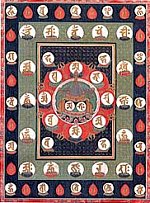
|
|
Shuji Mandala 種字曼荼羅
Saikokuji Temple 西國寺
Shingon temple in Hiroshima.
Above mandala is actually a Hokke Mandala (Lotus Mandala), one using Sanskrit syllables to represent the deities.
Photo courtesy this J-Site
|
|
 Shuji Mandala 種字曼荼羅. Also called the Hō (Ho, Hou) Mandara法曼荼羅. One of four basic artistic/stylistic mandala cateogories, one wherein deities are represented by Sanskrit syllables. See also Sanmaya Mandala (symbolic objects), Katsuma Mandala (three-dimensional images), and Shishu Mandala (human form). Shuji Mandala 種字曼荼羅. Also called the Hō (Ho, Hou) Mandara法曼荼羅. One of four basic artistic/stylistic mandala cateogories, one wherein deities are represented by Sanskrit syllables. See also Sanmaya Mandala (symbolic objects), Katsuma Mandala (three-dimensional images), and Shishu Mandala (human form).
Shūnanzan (Shunanzan) Mandala 終南山曼荼羅. Reflects Taoist influences. Classified as a Star Mandala (Hoshi Mandala).
Songyō (Songyo) Mandala 尊形曼荼羅. Mandala of Worship. Also known as Honji Suijaku Mandala (Mandala of True and Manifest Deities). The latter depicts Shintō (Shinto) deities (Kami 神) as manifestations (Suijaku 垂迹) of their Buddhist counterparts (Honjibutsu 本地仏), and are meant to represent Shinto-Buddhist unity. See Kasuga Mandala for clarification. The former is a type of Suijakuga 垂迹画 (paintings based on theories of Buddhist/Shinto unity). The art form is devotional (usually a large hanging scroll) showing shrine deities in human form. The deities are dressed in either their Shintō or Buddhist attire and arranged in geometric composition. There are many types of mandala that represent the unity of Buddhist and Shinto deities. See Suijaku Mandala for a larger list of such mandala.
 Sonshō (Sonsho) Mandala 尊勝曼荼羅. Classified as a Besson Mandala, one devoted to a single deity in the Buddha Crown Family. It evolved from a cult centered around Butchō Sonshō Darani 仏頂尊勝陀羅尼 (Butcho Soncho Darani , Skt. = Usnisavijaya-dharan; Taisho No. 967). It is used in the Sonshō Rite (Sonshōhō, Shonshoho 尊勝法), which is performed for longevity and the absolution of sins. In Japan, many pieces are extant. There are three main types: (1) Dainichi 大日 depicted in center surrounded by Eight Great Butchō 仏頂 (Buddha-Crown), along with Fudō (Fudo) 不動 inside a triangle symbolizing fire and Gōzanze (Gozanze) 降三世 inside a semicircle symbolizing wind that are shown in the lower left and lower right portions. (2) Dainichi surrounded by Eight Bodhisattva as listed in the Hachi Daibosatsu Mandara Kyō 八大菩薩曼荼羅経 or the Sutra of the Mandala of the Eight Great Bodhisattva, Taisho No. 1167 (but only line drawings of this type are still extant). (3) Omits the eight deities altogether and consists of a triad composed of Dainichi, Fudō and Gōzanze. A famous extant three-dimensional example of this mandala is preserved at Kongōji (Kongoji) Temple 金剛寺 in Osaka. Sonshō (Sonsho) Mandala 尊勝曼荼羅. Classified as a Besson Mandala, one devoted to a single deity in the Buddha Crown Family. It evolved from a cult centered around Butchō Sonshō Darani 仏頂尊勝陀羅尼 (Butcho Soncho Darani , Skt. = Usnisavijaya-dharan; Taisho No. 967). It is used in the Sonshō Rite (Sonshōhō, Shonshoho 尊勝法), which is performed for longevity and the absolution of sins. In Japan, many pieces are extant. There are three main types: (1) Dainichi 大日 depicted in center surrounded by Eight Great Butchō 仏頂 (Buddha-Crown), along with Fudō (Fudo) 不動 inside a triangle symbolizing fire and Gōzanze (Gozanze) 降三世 inside a semicircle symbolizing wind that are shown in the lower left and lower right portions. (2) Dainichi surrounded by Eight Bodhisattva as listed in the Hachi Daibosatsu Mandara Kyō 八大菩薩曼荼羅経 or the Sutra of the Mandala of the Eight Great Bodhisattva, Taisho No. 1167 (but only line drawings of this type are still extant). (3) Omits the eight deities altogether and consists of a triad composed of Dainichi, Fudō and Gōzanze. A famous extant three-dimensional example of this mandala is preserved at Kongōji (Kongoji) Temple 金剛寺 in Osaka.
Star Mandala. See Hoshi Mandala 星曼荼羅 above; also see Hokuto Mandala. Numerous photo as well under those two entries.
Suijaku Mandala 垂迹曼荼羅. Associated with Shintō (Shinto) deities and their Buddhist counterparts. Also known as the Sujiakugyō (Suijiakugyo) Mandara 垂迹形曼荼羅 or Suijakushin Mandara 垂迹神曼荼羅. In such mandala, the Shintō deities (kami 神) are represented as Japanese courtiers, Buddhist monks (aka Sōgyō Hachiman 僧形八幡), young boys (Dōji, Doji, Douji 童子), or Chinese ladies. Another variation is the Honji Mandala 本地曼荼羅 (or Honjibutsu Mandala 本地仏曼荼羅), wherein the Shintō kami are represented by their Buddhist counterparts (Honjibutsu本地仏). Another version is the Honjaku Mandala 本迹曼荼羅, an abbreviation of Honji Suijaku Mandala 本地垂迹曼荼羅. In the latter, the kami are represented in their manifest Shinto form (Suijaku 垂迹) and in their true Buddhist form (Honjibutsu 本地仏). See Kasuga Mandala and Hie Sanno Mandala for more details and photos.
 Taima Mandala 当麻曼荼羅. Mandala of Taima. <Says JAANUS> “The most complete depiction of the Kangyou Hensou 観経変相, or "transformation scene” of the KANMURYOUJUKYOU 観無量寿経. It is a religious image usually hung to the left of the main altar in the sanctuary of a Jōdo temple. The pictorialization was based on a commentary on the Buddhist sutra by Shandao 善導 (613-681). The appellation arose because the original version in Japan has been handed down at Taimadera 当麻寺, Nara. One of the Three Jōdo Mandala (Jōdo Sanmandara), which are revered by followers of Pure Land Buddhism. As with the Amida Jōdo Hensou 阿弥陀浄土変相, the painting subject focuses on an Amida Triad (Amida Sanzon 阿弥陀三尊), with Amida surrounded by many Bodhisattva. In the center background is an ornate palace representing Amida's paradise, the Gokuraku Jōdo 極楽浄土. In addition, the left vertical pannel or court shows the story of Prince Ajatasatru (Jp: Ajase Taishi 阿闍世太子) from the preface of the sutra. In the right verticle and lower horizontal courts the story is continued with additional depictions of the Sixteen Contemplations (Juurokukan 十六観) that Shaka (Historical Buddha) preached to the king's wife as a guide to visualize Amida's paradise. Thirteen Contemplations are arranged on the right side and the remaining three contemplations, commonly referred to as the Nine Stages of Rebirth (Kubon Raigou 九品来迎 or Kubon Oujou 九品往生), are placed in the bottom court. Scholars believe the original Taima Mandara was a large-scale embroidery imported from Tang China. It is believed that in 763 during the Nara period Chuujou Hime 中将姫 had it woven with lotus threads (gūshi, guushi, gushi, 藕糸) based on a vision she had experienced. Thus the original woven work is sometimes also called the Gūshi (Gushi) Mandara 藕糸曼荼羅. The miraculous weaving of the 4.5 meters square tsuzure-ori 綴織, usually translated as "figured (hand woven) brocade," is said to have been accomplished by a nun who was believed to be a human incarnation of Kannon 観音, the main attendant to Amida. This 8c work is still preserved today at Taimadera 当麻寺 in fragments with a great many Kamakura-period repairs. From the Heian period (10c), with the increasing popularity of Pure Land beliefs, the work grew ever more revered. In the Kamakura period, Hōnen's 法然 (1133-1212) disciple Shōkū 証空 (1177-1247), founder of the Seizan 西山 branch of the Jōdo sect, Jōdoshū 浄土宗, actively propagated the teachings of the Taima Mandala. Hence, at this time numerous commentaries on the iconography were written and many copies of various sizes were also painted. The most notable was the well known work from 1217 preserved at Zenrinji Temple 禅林寺 in Kyoto, which is regarded as the closest extant copy. Numerous later copies also exist. Moreover, the 13th-century illustrated scrolls of the "Legends of the Taima Mandala" (Taima Mandara Engi Emaki 当麻曼荼羅縁起絵巻) at Kōmyōji Temple 光明寺, with its vivid illustrations and text of the mandala's miraculous origins, played an important role in the diffusion of Taima Mandala beliefs. <end JAANUS quote> Taima Mandala 当麻曼荼羅. Mandala of Taima. <Says JAANUS> “The most complete depiction of the Kangyou Hensou 観経変相, or "transformation scene” of the KANMURYOUJUKYOU 観無量寿経. It is a religious image usually hung to the left of the main altar in the sanctuary of a Jōdo temple. The pictorialization was based on a commentary on the Buddhist sutra by Shandao 善導 (613-681). The appellation arose because the original version in Japan has been handed down at Taimadera 当麻寺, Nara. One of the Three Jōdo Mandala (Jōdo Sanmandara), which are revered by followers of Pure Land Buddhism. As with the Amida Jōdo Hensou 阿弥陀浄土変相, the painting subject focuses on an Amida Triad (Amida Sanzon 阿弥陀三尊), with Amida surrounded by many Bodhisattva. In the center background is an ornate palace representing Amida's paradise, the Gokuraku Jōdo 極楽浄土. In addition, the left vertical pannel or court shows the story of Prince Ajatasatru (Jp: Ajase Taishi 阿闍世太子) from the preface of the sutra. In the right verticle and lower horizontal courts the story is continued with additional depictions of the Sixteen Contemplations (Juurokukan 十六観) that Shaka (Historical Buddha) preached to the king's wife as a guide to visualize Amida's paradise. Thirteen Contemplations are arranged on the right side and the remaining three contemplations, commonly referred to as the Nine Stages of Rebirth (Kubon Raigou 九品来迎 or Kubon Oujou 九品往生), are placed in the bottom court. Scholars believe the original Taima Mandara was a large-scale embroidery imported from Tang China. It is believed that in 763 during the Nara period Chuujou Hime 中将姫 had it woven with lotus threads (gūshi, guushi, gushi, 藕糸) based on a vision she had experienced. Thus the original woven work is sometimes also called the Gūshi (Gushi) Mandara 藕糸曼荼羅. The miraculous weaving of the 4.5 meters square tsuzure-ori 綴織, usually translated as "figured (hand woven) brocade," is said to have been accomplished by a nun who was believed to be a human incarnation of Kannon 観音, the main attendant to Amida. This 8c work is still preserved today at Taimadera 当麻寺 in fragments with a great many Kamakura-period repairs. From the Heian period (10c), with the increasing popularity of Pure Land beliefs, the work grew ever more revered. In the Kamakura period, Hōnen's 法然 (1133-1212) disciple Shōkū 証空 (1177-1247), founder of the Seizan 西山 branch of the Jōdo sect, Jōdoshū 浄土宗, actively propagated the teachings of the Taima Mandala. Hence, at this time numerous commentaries on the iconography were written and many copies of various sizes were also painted. The most notable was the well known work from 1217 preserved at Zenrinji Temple 禅林寺 in Kyoto, which is regarded as the closest extant copy. Numerous later copies also exist. Moreover, the 13th-century illustrated scrolls of the "Legends of the Taima Mandala" (Taima Mandara Engi Emaki 当麻曼荼羅縁起絵巻) at Kōmyōji Temple 光明寺, with its vivid illustrations and text of the mandala's miraculous origins, played an important role in the diffusion of Taima Mandala beliefs. <end JAANUS quote>
Tairaku Mandala 大楽曼荼羅. Mandala of Great Bliss. See Rishukyō Mandala.
Taizōkai (Taizokai, Taizoukai) Mandala 胎蔵曼荼羅. Womb World Mandala or Matrix Mandara. It is one of the most popular mandala forms among Japan's Esoteric sects. Paired with the Kongōkai Mandala, it is known as the Ryōkai Mandala (or Mandala of the Two Realms/Worlds). Both are typically hung in the halls of Esoteric temples, one on the east side and the other on the west. The Taizōkai Mandara is referred to as the Mandala of Principle (Ri Mandara 理曼荼羅) or Mandala of Cause (In Mandara 因曼荼羅). Taizōkai is the abbreviated form of Daihitaizōshō (Daihitaizosho) Mandara大悲胎蔵生曼荼羅 (Mandala Born of the Womb of Great Compassion), and this abbreviated term was used commonly instead of its longer parent from the 8th century onward in Japan. The Taizōkai is described in the Dainichikyō (Dainichikyo) Sutra大日経 (Skt. = Vairocanabhisambodhi Sutra, also known as the Mahavairocana Sutra). Its precursors were the Taizō Zuzō (Taizo Zuzo) and Taizō Kyūzuyō (Taizo Kyuzuyo). One of the most popular versions of the Taizōkai, still widely used today, is the Genzu Mandala.
Taizō Kyūzuyō (Taizo Kyuzuyo) 胎蔵旧図様. A primitive early form of the Taizōkai Mandala; iconographical line drawings in handscroll form that predate the Genzu Mandala; an extant copy dated to 1193 is in the Mutō collection; it depicts 242 deities.
Taizō Zuzō (Taizo Zuzo) 胎蔵図像. A primitive early form of the Taizōkai Mandala; iconographical line drawings in handscroll form that predate the Genzu Mandala. Extant reproductions dated to 1194 and 1274 depict 324 deities. These reproductions are preserved at the Nara National Museum.
Takao Mandara 高雄曼荼羅 at Jingoji Temple 神護寺 in Kyoto. Considered a famous example of the Ryōkai Mandala and a designated national treasure. One of the mandala brought back from China to Japan by Priest Kūkai (774 - 835 AD), from which other copies (with variations) were made.
Tateyama Mandala 立山曼荼羅. Closely associated with the Pure Land (Jōdo, Jodo 浄土) sects devoted to Amida Buddha. Tateyama is a mountainous region in the eastern part of Japan's Etchu area (present day Toyama Prefecture), and has long been considered a sacred mountain. In the Edo Period, proselytizing warrior monks carried Tateyama mandala images across all of Japan, using them as pictorial teaching materials. Amida and 25 Welcoming Bodhissattva (including Kannon and Seishi) are shown welcoming believers into Amida’s Western Paradise. Other celestial beings appear as well in the pictorial paradise above the Tateyama range (the range represents Amida’s Western Paradise). The lower section depicts various scenes of hell, such as a blood pool, a limbo for children, and a fiery chariot.
Tendai 天台. Scholar-monk Saichō 最澄 (767 - 822) founded Japan's Tendai sect. The Tendai school originated in China, where Saichō (Saicho) had traveled to study the teachings (in the same fleet of ships that also carried his famous colleague Kūkai 空海). Saichō returned to Japan in 805 with numerous text, relics, and artwork to spread the Tendai teachings and soon thereafter established the Tendai Sect under the imperial sanction of Emperor Kanmu 桓武 (737–806). Saichō is credited with introducing the Sanjūshichisonyō (Sanjushichisonyo) 三十七尊様, a painting which he brought back from China. It is a type of Kongōkai Mandala depicting 37 deities. Saichō also introduced the Daibutchō Tsūyō Mandala, a variety of Besson Mandala. Once transplanted to Japanese soil, Tendai teachings flowered. Saichō's sect attempted a synthesis of various Buddhist doctrines, including faith in the Lotus Sutra, Esoteric rituals, Amida (Pure Land) worship, and Zen concepts. Tendai gained great court favor, rising to eminence in the late Heian era. The Tendai shrine-temple multiplex (then and now) is located at the foot of Mt. Hiei 比叡 in Shiga Prefecture. The shrine stronghold is known as Hie Sannōsha 日吉山王社 (also called Hiyoshi Sannōsha), while the Buddhist stronghold is known as Enryakuji Temple 延暦寺. Despite Saichō's many contributions, the flowering of mandala artwork in Japan is credited primarily to Kūkai and his Shingon sect. Saichō received the full precepts at the age of 19 (around 786) at Tōdaiji 東大寺, the same place as his famous contemporary Kūkai, who received the precepts in 795. See Hie Sannō Mandala for more details and photo. See Esoteric Buddhism for more details.
Tenkawa Benzaiten Mandala 天川弁才天曼荼羅. Tenkawa Jinja Shrine 天河神社 in Nara Prefecture is a sacred site and practice location for Shugendō 修験道 devotees. Shugendō is a syncretic sect that combines Taoist magic, Shinto beliefs, and Estoteric doctrines. Tenkawa Jinja is also devoted to the Goddess Benzaiten, and hence is also called Tenkawa Dai-Benzaitensha. The Tenkawa Benzaiten Mandala (shown below) was used to invoke her aid for bountiful harvests and good fortune.
|
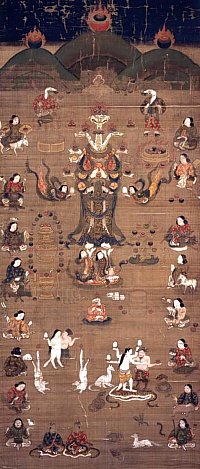
|
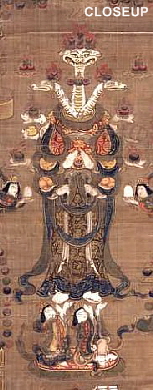
|
|
Tenkawa Benzaiten Mandala 天川弁才天曼荼羅図
Nōman-in Temple 能満院 in Sakurai City 桜井市, Nara Pref.
Muromachi Era, 1546 AD, Color on Silk, H 99.4 cm W 39.4 cm
Courtesy Treasures of Nara Prefecture | Large Photo | J-Description
At the top of the mandala are three sacred gems (hōju 宝珠) with flame nimbus (kaenkō 火焔光) shown atop three mountains. At the center of the mandala is a 10-armed Benzaiten shown in human form but with three serpent heads. Around her are the Jūgo Dōji 十五童子 (Fifteen Sons or Disciples of Benzaiten), all holding various symbolic objects. Strewn everywhere throughout the painting are images of the Hōju 宝珠 (Sacred Gem), which represent the power to expel evil, cleanse corruption, remove suffering, and grant every wish. In some esoteric traditions in Japan, this sacred jewel is said to have emerged from the head of the dragon king (Ryū-ō 竜王; dragons are a type of serpent). The snake-headed Benzaiten represents the syncretic Shinto-Buddhist deity known as Ugajin 宇賀神 or Uga Benzaiten. The foxes and male-female pairs inside the painting symbolize the merging of Oinari 稲荷 (also written Inari; he is the Japanese god of rice, his messenger is the fox) with the esoteric deity known as Dakiniten 荼吉尼天, a Hindu goddess adopted into the Buddhist pantheon. Her messenger is a white fox. Another similar piece is kept at Ishiyama-dera 石山寺, a Shingon temple in Otsu City (Shiga Pref.). Such syncretic pieces are relatively rare in Japan.
For a few more details in Japansese, see:
|
|
Tobu Mandala 都部曼荼羅. See Toe Mandala.
Toe Mandala 都会曼荼羅. Also called the Tobu Mandara 都部曼荼羅. A mandala form depicting myriad deities from all "divisions" or "families" (Jp. = Bu 部) in the Buddhist pantheon. The most widely known type of Toe Mandala in Japan is called the Ryōkai Mandala, commonly rendered in English as the Mandala of the Two Worlds. One of four major mandala categories in Japan. See Quick Quide.
Tōhon (Tohon) Hokuto Mandala 唐本北斗曼荼羅. Of Chinese origin and devoted to Shijōkō Butchō (Shijoko Butcho) 熾盛光仏頂. Classified as a type of Hoshi (Star) Mandala. Also see Daibutchō Mandala for descriptions of numerous Butchō deities.
Tosotsuten Mandala 兜率天曼荼羅. Appeared in the Kamakura period; depicted Miroku in Tusita Heaven. See Miroku Mandala for details and photo.
 Yoshino Mandala 吉野曼茶羅. Devotional paintings of the deities, the shrines, and the landscapes of the Yoshino 吉野 area, located in the Ōmine (Oomine) 大峰 mountains near Nara. Such mandala are sometimes devoted to the syncretic Shintō-Buddhist deity Zaō (Zao) Gongen 蔵王権現 (Avatar Zaō) surrounded by deities from the eight other shrines in the area. Relatively few Yoshino Mandala are extant, but they appeared frequently in the Muromachi and Edo periods, when the ascetic practises of the Shugendō (Shugendo) 修験道 sect were still widespread. Zaō is one of the most important deities of the syncretic Shugendō sects, a diverse tradition of mountain ascetic traditions associated with Shinto beliefs, Taoism, magic, supernatural powers, and Esoteric (Tantric) Buddhism. Zao serves as the protector deity of sacred Mt. Kimpusen (Mt. Kinpu) 金峰山 in Japan's Nara prefecture and is considered the local Japanese Shinto manifestation (avatar = gongen) of three Buddhist divinities -- the Historical Buddha (past), Kannon Bodhisattva (present), and Miroku Buddha (future). Kimpusenji Temple is the head temple of Japan’s Shugendō sect even today.The mountains of the Yoshino area are centers of the Shugendō tradition, which traces its origins back to the 7th century and the wandering holy man En no Gyōja 役行者 (En no Gyoja), who had prayed for a powerful deity to assist him. After various visions, the deity Zaō finally appeared and henceforth became the sect’s tutelary deity. In the all-important Ryōkai Mandala (a pair of mandala known as the Taizōkai and Kongōkai), Shugendō adepts are represented travelling through the mountains between Yoshino and Kumano (see Kumano Mandala). By the late Heian period, Yoshino became a major pilgrimage site for the court and commoner alike, and was mentioned often in poetry and literature from the 10th century onward. It served for a short time as the capital of Emperor Godaigo 後醍醐 (r.1318-1339), and is even today very famous for its scenic beauty and cherry blossoms. The latter, according to legend, were planted in the 7th century by En no Gyōja 役行者 and dedicated to the area’s tutelary deity, Zaō Gongen. A rare Yoshino Mandara devoted to Zaō is owned by Nyoirinji Temple 如意輪寺 at Mt. Yoshino. Yoshino Mandala 吉野曼茶羅. Devotional paintings of the deities, the shrines, and the landscapes of the Yoshino 吉野 area, located in the Ōmine (Oomine) 大峰 mountains near Nara. Such mandala are sometimes devoted to the syncretic Shintō-Buddhist deity Zaō (Zao) Gongen 蔵王権現 (Avatar Zaō) surrounded by deities from the eight other shrines in the area. Relatively few Yoshino Mandala are extant, but they appeared frequently in the Muromachi and Edo periods, when the ascetic practises of the Shugendō (Shugendo) 修験道 sect were still widespread. Zaō is one of the most important deities of the syncretic Shugendō sects, a diverse tradition of mountain ascetic traditions associated with Shinto beliefs, Taoism, magic, supernatural powers, and Esoteric (Tantric) Buddhism. Zao serves as the protector deity of sacred Mt. Kimpusen (Mt. Kinpu) 金峰山 in Japan's Nara prefecture and is considered the local Japanese Shinto manifestation (avatar = gongen) of three Buddhist divinities -- the Historical Buddha (past), Kannon Bodhisattva (present), and Miroku Buddha (future). Kimpusenji Temple is the head temple of Japan’s Shugendō sect even today.The mountains of the Yoshino area are centers of the Shugendō tradition, which traces its origins back to the 7th century and the wandering holy man En no Gyōja 役行者 (En no Gyoja), who had prayed for a powerful deity to assist him. After various visions, the deity Zaō finally appeared and henceforth became the sect’s tutelary deity. In the all-important Ryōkai Mandala (a pair of mandala known as the Taizōkai and Kongōkai), Shugendō adepts are represented travelling through the mountains between Yoshino and Kumano (see Kumano Mandala). By the late Heian period, Yoshino became a major pilgrimage site for the court and commoner alike, and was mentioned often in poetry and literature from the 10th century onward. It served for a short time as the capital of Emperor Godaigo 後醍醐 (r.1318-1339), and is even today very famous for its scenic beauty and cherry blossoms. The latter, according to legend, were planted in the 7th century by En no Gyōja 役行者 and dedicated to the area’s tutelary deity, Zaō Gongen. A rare Yoshino Mandara devoted to Zaō is owned by Nyoirinji Temple 如意輪寺 at Mt. Yoshino.
SOURCES
PHOTOS
LEARN MORE

Last Revision = Feb. 21, 2011
|
|